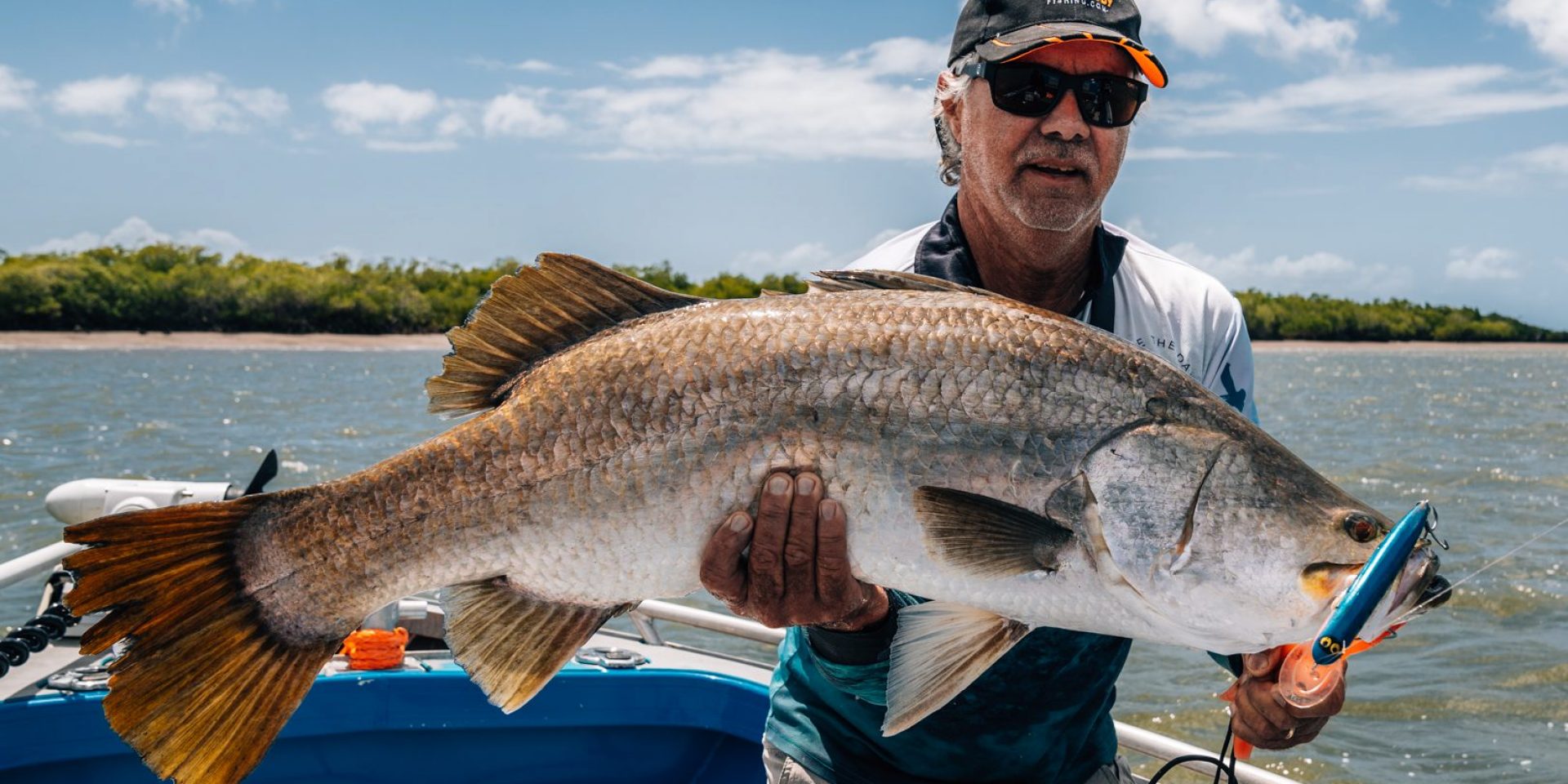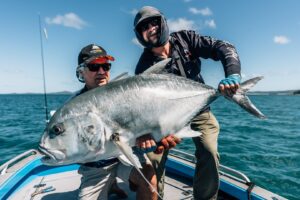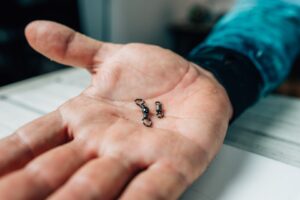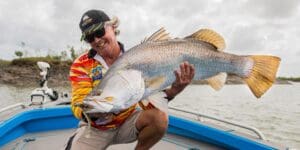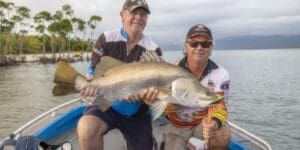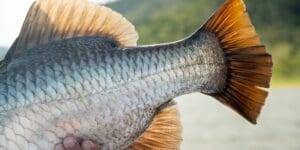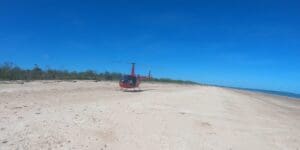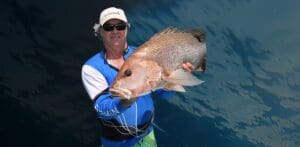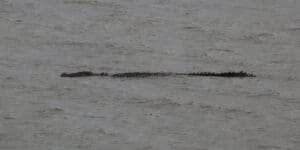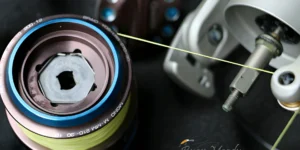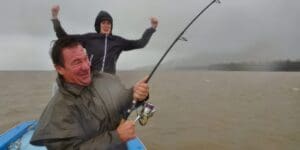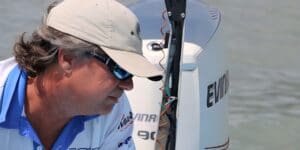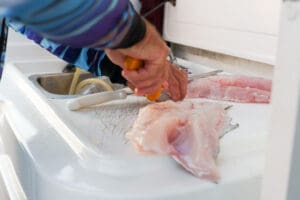How to Catch Big Barramundi with Ryan Moody
One of the most frustrating things about barramundi fishing is catching them one day and not the next, catching rats instead of metries, or not catching your target species at all… Despite spending thousands on boats, gear, tackle and travel.
A great Barra angler is a consistent angler and consistency comes from adapting to different situations. It’s all about recognizing patterns and when conditions change, understanding that fish will move. It’s about fishing with strategy. And that’s where we can help.
I’ve spent over 30 years as a Barra fishing guide, capturing over 2000 saltwater metres plus barra for clients, earning a reputation for big fish. As such, anglers flew in from all over the world to fish with me.
But not to a remote area out the back of NT. But around North Queensland’s biggest city – Townsville. And also around what is probably one of the most beautiful fishing destinations in the world – Hinchinbrook Island.
In other words, once you know how big barra move, you don’t have to go to the back of Beyond to catch one!
Take a look at our big barra series to get a taste of what it’s like to hook a metre plus of leaping gleaming silver saltwater barramundi.
Understanding Barramundi
Take a survey of the top 5 fish any Aussie angler wants to catch and a saltwater caught, metre plus barra will be invariably in that top 5.
I say saltwater caught because you can also pick up a metery from stocked impoundments and billabongs. And while they are an impressive catch, they just don’t hold the same iconic status as a wild-caught fish.
Perhaps because saltwater fish fight harder and also because their movements in saltwater are much more difficult to nut out, making them harder to catch.
Regardless of size and location, catching one’s first barramundi is a euphoric occasion, even more so if they are over that magical metre mark.
I certainly remember my first metre plus barra. I was only 15 and it was the one and only metery I have ever killed. Didn’t know any better at age 15. Now I get so much more satisfaction from watching them swim away.
2000 Metre Plus Saltwater Barra
Since then I’ve caught over 2030 stunning metre plus saltwater barra for myself (even made the news when we hit 2000) and my guided fishing clients. During my charter career, I always released fish over 90 cm, and in the later stages of my career a boat limit of one per person.
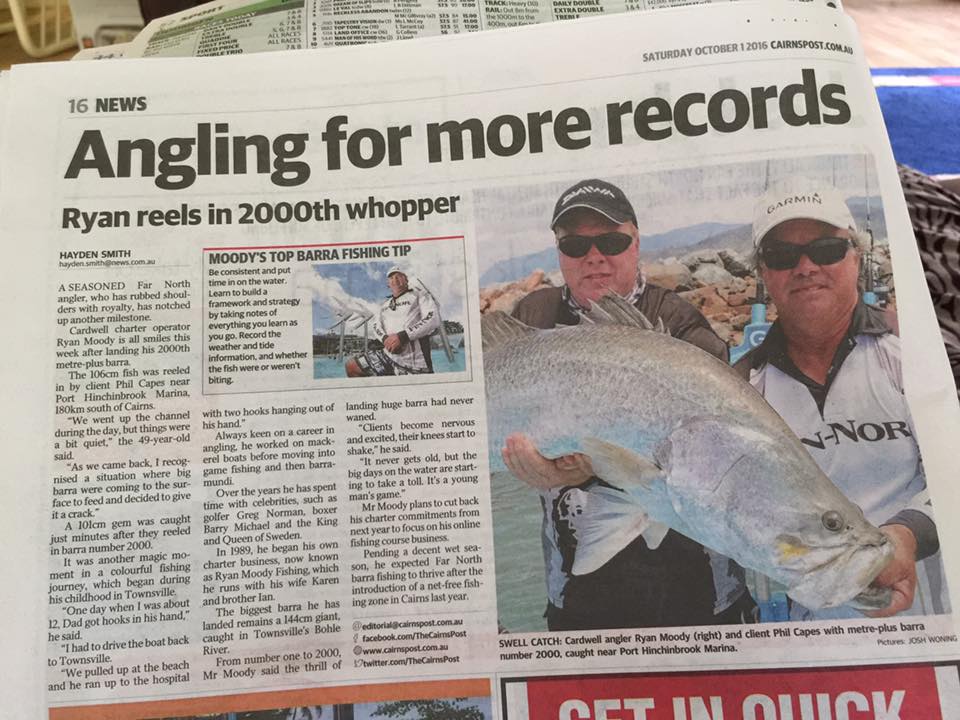
If you’re going to take a barra for the table, smaller fish are better. Check out my neat filleting trick in this old blog – the first educational video ever made.
Indeed, since beginning my charter career in the early 90’s, I’ve watched things change so much.
In the early days, anglers wanted to catch the guide fee in fillets. Whereas in the later years, we released most fish to fight another day.
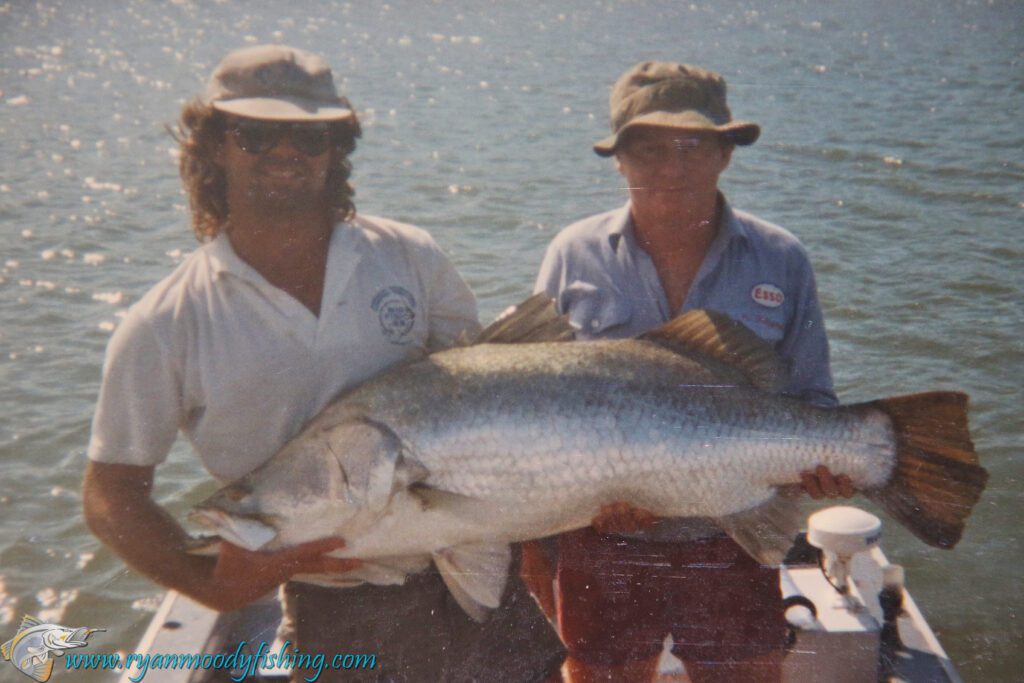
Australia’s Premium Inshore Sportsfish
Barramundi (Lates calcarifer) has long been Australia’s premium inshore sport fish and for many years were hard to catch species for most anglers.
However, in the last couple of decades, due to a few pioneers in the fishery and education that followed – see our Barra Basics course putting anglers onto big barra since 2014, Barramundi are now being caught by many Recreational anglers right across the northern parts of Australia.
Catching a big barramundi is a knee-trembling experience and is interrupted by several jumps (watch our big barra series here) on most occasions. Their big bucket mouth is capable of a sudden inhalation that anglers can feel right through the rod and can rip the rod out of your hand if you are not on the ball.
They have a large paddle-like tail that is instrumental in providing those short sharp bursts that give them their renowned fighting ability.
Sometimes in winter, they use it to warm up the blood vessels by hanging it upside down and sticking it out of the water – an incredible tease as they will not bite in this mode.
Barramundi on the Table
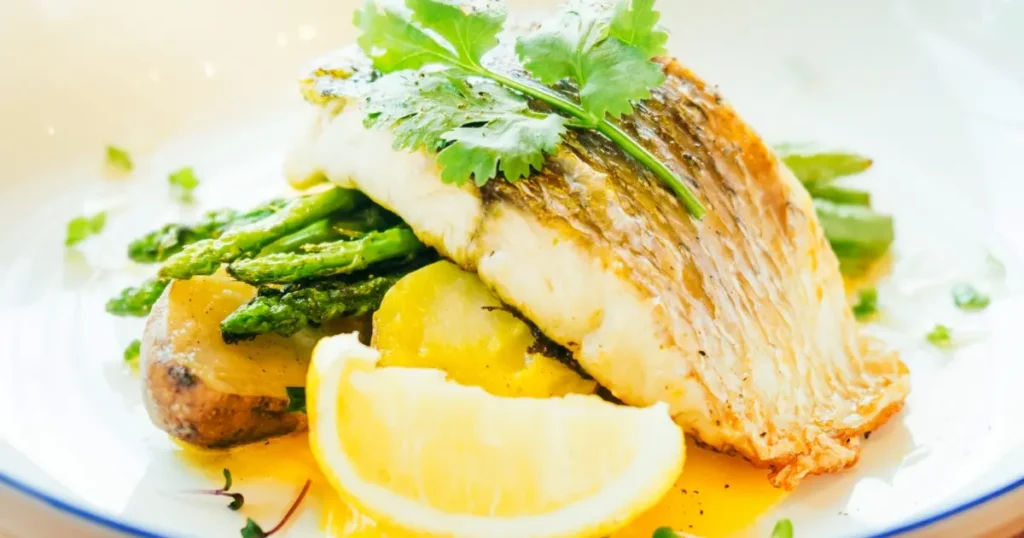
Barramundi are fine table fish especially the smaller ones caught in saltwater. See our brilliant barra filleting trick here.
Larger and freshwater Barramundi are not so good and are mostly Sportfish being released on most occasions.
Impoundment fish can suffer from barotrauma, and we show you how to deal with a barra suffering from barotrauma in this post from Proserpine Dam.
They have long been a commercially targeted fish with the use of gillnets but in recent times the commercial fishery has come under attack from conservation interests and the livelihoods of the net fishers have all been pretty much closed down.
So most Barramundi in the restaurants are mostly all farmed fish from the aquaculture sector.
That means if you want a feed of tasty fresh saltwater Barra (the best kind), you’ll need to go out and catch it yourself!
Distribution
Whilst most anglers think of Barra as an Aussie fish, they are widely distributed throughout coastal areas of the entire Indo-West Pacific region – from the eastern edge of the Persian Gulf to China, Taiwan, southern Japan southward to Papua New Guinea, and northern Australia.
Distribution in Australia can be as far south as Brisbane on the east coast, all the way around to Shark Bay in Western Australia.
They have a close relative in Japan called the Akame (which means red eye) that looks virtually identical.
A cousin from Africa called the Nile Perch grows much larger and is born and stays in the freshwater.
At one point there was a movement to introduce the Nile Perch into Australia, however, this would have been a disaster. Allowing adult Nile Perch to prey on juvenile barramundi (and everything else).
Changing Sex
One unique trait of the Barramundi is that they are protandrous hermaphrodites. Basically, they are all born as males and change their sex to female once they reach about 80 cm in the saltwater.
However, nature does have ways of self-regulation depending on how many breeders are around. I have seen them change sex as early as 65 cm when heavy commercial netting had taken many breeders from a system.
They are truly euryhaline, which means they can transition from fresh to saltwater very easily, so they are a very resilient fish all-round. It is a remarkable adaptation which that very few fish have.
Life Cycle
Although they can live in both fresh and saltwater, they only breed in the salt. Hence during heavy rains, many stocked impoundment fish can perish as they travel over the dam wall to their death in their quest to breed.
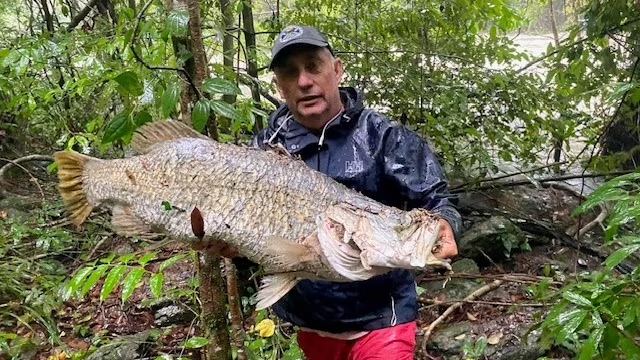
It was once thought they wait until the first rains of the monsoon before they spawn but this is not always the case.
In my experience, fish from Townsville and Hinchinbrook typically spawn around the full moon in December and January, generally near the mouth of estuaries, regardless of rainfall.
In the Northern Territory where the monsoon is typically more active, fish spawn between September and March, again in marine bays and river mouths.
The larvae spend around 6 months in the coastal areas, living in the mangrove nurseries and coastal flats inundated only at high tide. They then make their way upstream to try and reach the freshwater lagoons. This is where they will spend their first 1 to 3 years, before making their way back to the salt to spawn as adults during the wet season.
There are those too that don’t make it to the fresh and grow up in the salt. These stunning silverfish have it tough when they’re young without the protection of the freshwater lagoons. The mortality rate is much higher in salt as herring and mullet will feed on them during the larval phase.
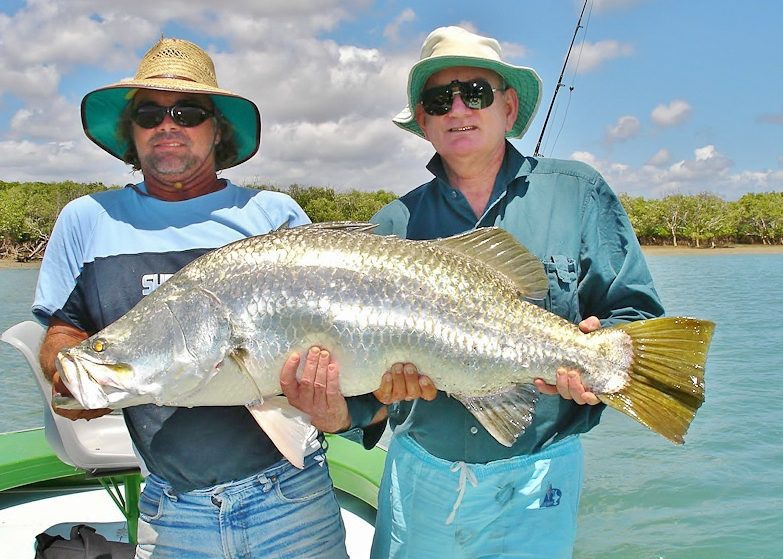
Fishing Closures
To protect spawning fish, Queensland Fisheries have implemented a Barramundi fishing closure from 1 Nov. to 31 Jan. on the East Coast. But in the Gulf of Carpentaria, the closure runs from 7 October to 1 January. Things do change so please check via the Qld Fisheries website in case our info goes out of date.
Case in point: The east coast Barramundi fishing closure times changed a few years ago from midday to midnight. The current (time of writing this post) closed season runs from midnight to midnight – e.g. from 12.01 am on the first day of the closure to 11.59 pm on the last day of the closure.
This means not that you must catch and release, but that you must not target Barra during this period. Which incidentally is the best time to catch the bigger fish.
However, it’s not all bad news for anglers. The Northern Territory does not have a closure and in Queensland, you can still fish the impoundments for stocked fish if you have a SIPS permit (get one here).
Even better, the Northern Territory’s Million Dollar Fish promotion runs over this period. Catch the tagged fish and win a million bucks, plus a ton of $10,000 tagged fish. In 2024 a teenage boy caught the million dollar fish and is now a millionaire.
Best Times and Conditions for Barramundi Fishing
Warmer Months
Barramundi are most active during the summer months when the water temperature is around 26-30 degrees celsius.
In Queensland as the weather warms during spring, they can start to get very aggressive, especially in October. But it’s not long until the closed season starts from 1st November to 1st February when saltwater fish become off-limits. Remember this when booking a barramundi fishing charter in Queensland.
As we’ve mentioned, during the closure you do have the option to head to the Northern Territory (be sure and register for the million-dollar fish) or northern Western Australia for saltwater fish.
Alternatively, you can head to freshwater impoundments to target them but it’s not everyone’s cup of tea. Click here for some great tips to target impoundment fish with lures.
But one plus side of impoundments is that it takes some pressure off the wild fish stocks. They provide a good alternative for anglers chasing their first metre-long Barramundi as they are easier to catch in impoundments.
From February to April is still a good time but can be restrictive with the monsoon and cyclone season causing flooding. These issues can make it hard for everyone who enjoys chasing them.
Cooler Periods
The winter period can still fish well at times but when it’s cooler, fish are more susceptible to sudden changes in weather and water temps.
Since they are not as active, it’s best to use live bait with live prawns being the most effective.
We have a comprehensive course on catching your own live bait, even in difficult weather conditions and at high tide. Well worth a look if you want to spend more time fishing and less time chasing live bait.
Methods of targeting Barra in winter can change a bit to try and get the best out of them.
The good news is they aggregate more in winter, so that’s when to go looking for their popular haunts, like deep holes, ledges, and snags.
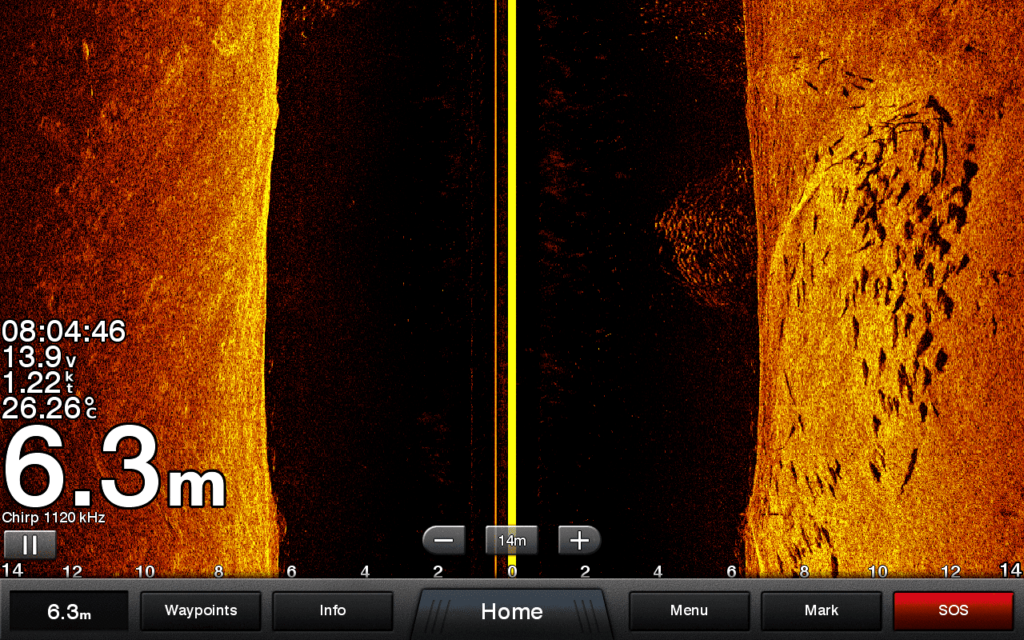
Additional Tools To Help You Find Aggregations
- Barra Strategies Workshop. Take the time to watch these videos on how I worked out Barra movements so well I can now predict where they will be based on conditions.
- Big Picture Sounder Workshop. A compliment to Barra’s strategies workshop, sign up for this one a few days later as they both have a 5-day tips email series. One thing at a time is always best – the man who chases two rabbits catches none.
Weather
When it comes to weather changes no matter what time of year, Barramundi can take time to adjust to instability.
In other words, unstable weather patterns and changes. You can generally tell these changes by changes in the barometer hectopascals (hPa).
Barramundi can take a several days before they come back on the bite and working out these patterns takes time on the water.
Windy cold snaps can see water temperature drop by 4 degrees overnight and trough lines can change the barometer to fluctuate outside of its normal parameters. These are 2 of the biggest changes they hate.
So if you see a big weather change coming, might be time to head to the pub.
An exception to this is if the weather change has been around for a while. So the change is the norm. We picked up this 125 cm big girl on a miserable day.
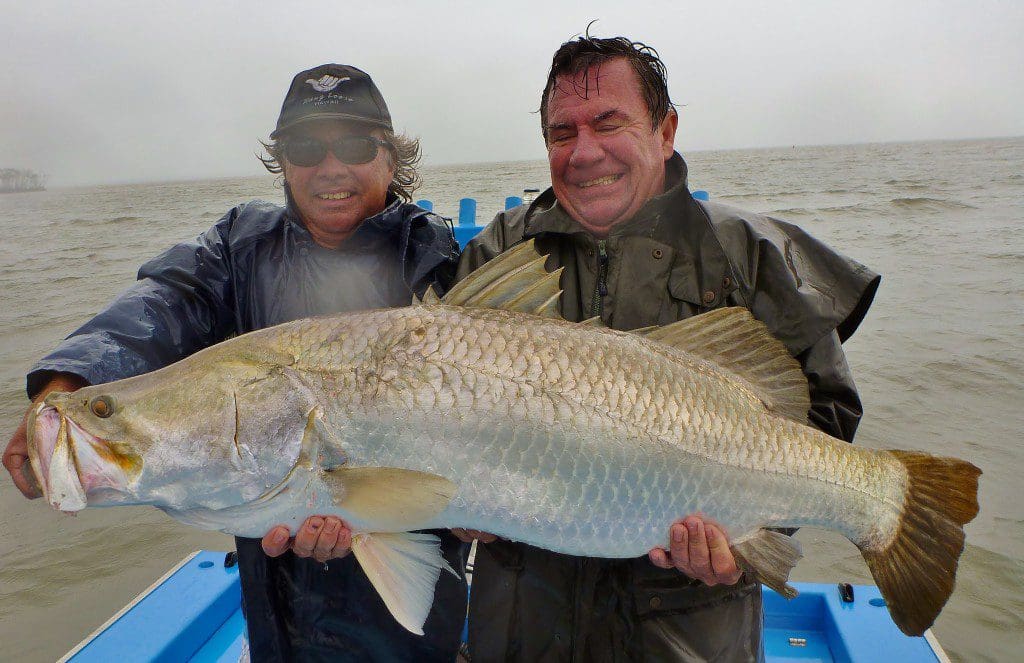
How Tides Influence Barramundi Fishing
For any angler targeting barramundi, understanding the tides is critical. These daily water level fluctuations play a major role in where barramundi will be and how they behave.
While there’s no single “best” tide for guaranteed success, understanding the effect of tidal movement will significantly boost your chances of landing a trophy Barra.
Smaller fish (schoolies) react differently to larger fish (metreys). Larger fish can often be found in the same haunts on the same tides for many years. See our blog > Big Fish Don’t move for more info.
The Power of Moving Water
Barramundi are opportunistic feeders. During slack tides (periods of minimal water movement at high and low tide), they tend to be less active.
However, when the tide starts to run (either incoming or outgoing), magic happens. The movement of water stirs up baitfish, flushing them out of hiding places like mangroves and creeks. This creates a feeding frenzy for barramundi, making them more active and likely to strike a well-presented lure or bait.
The moving water will make barra move from areas related to their held-up dormant state to other areas for active deliberate feeding.
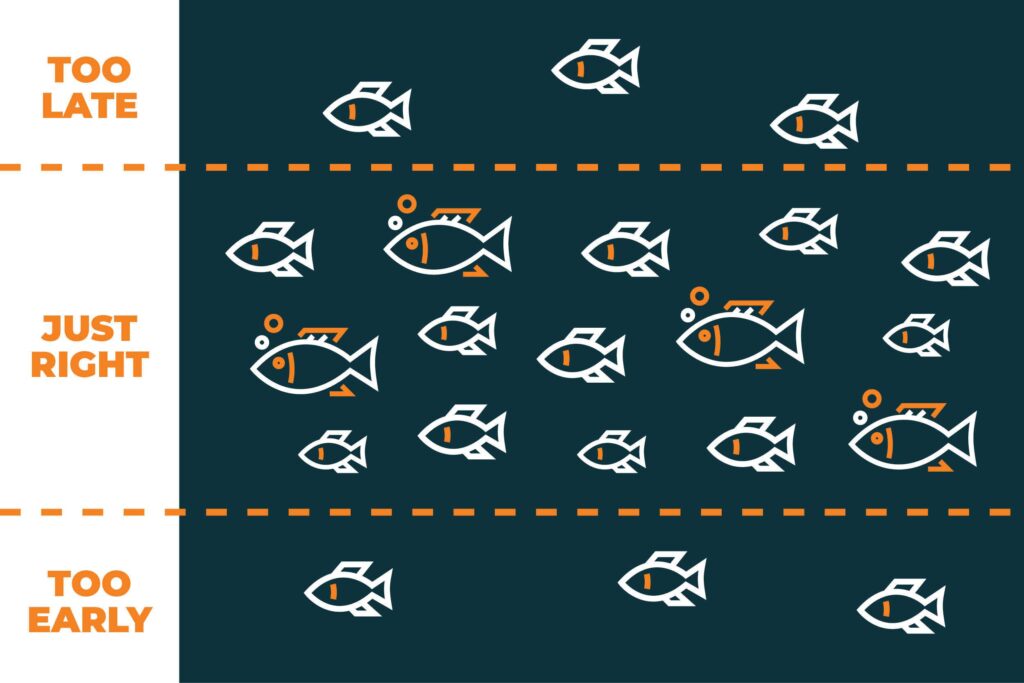
Ebb Tide Advantages
Many seasoned barramundi anglers swear by the outgoing or ebb tide. As the water level drops, it exposes previously submerged flats and pushes baitfish towards deeper water. This concentrated food source attracts barramundi, making them easier to target. Here’s why the ebb tide can be particularly productive
Concentrated Bait: The receding water squeezes baitfish into smaller areas, creating a prime feeding ground for barramundi. Target areas like creek mouths and gutters where baitfish are likely to funnel through.
Exposed Structure: The lower water level reveals submerged logs, rock bars, and other structures that barramundi like to ambush prey around. Cast lures or live bait strategically near these structures for increased chances of a strike.
Live Bait Imitations: When using live bait on an ebb tide, you can mimic an injured or disoriented baitfish struggling against the current. This distressed presentation can be irresistible to barramundi and pinning your live bait to mimic the injured fish is an advantage as well.
Land-based anglers (and even boat anglers) can benefit from low tide reconnaissance This will show you what is under the water that may attract fish that have shallow water habits like barramundi. > Watch low tide reconnaissance here.
Sign up below to receive our gear and tackle cheat sheet for fishing Northern Australia.
Flood Tide Potential
While the ebb tide gets a lot of love, the incoming, or flood, tide shouldn’t be discounted. Here’s how a rising tide can be a successful strategy:
Freshwater Influx: The flood tide often brings in cooler, oxygen-rich water from offshore or rivers. This can trigger barramundi feeding activity, especially during the hotter parts of the day.
Submerged Structure: As the water level rises, familiar structures become partially submerged, creating ambush points for barramundi waiting for unsuspecting prey.
Mangrove Maze: The rising water floods previously dry mangrove areas. This entices barramundi to push into these structures looking for easy meals. Target the edges of these mangroves with lures or flies that resemble small baitfish or prawns.
Beyond the Basics: Understanding the type of tide (spring vs neap) and the influence of moon phases can further optimize your barramundi fishing strategy. Spring tides, with their larger tidal movements, can create more aggressive feeding activity, while neap tides might require more finesse. Full and new moon periods often coincide with spring tides, and these times can be prime for targeting big barramundi.
There are also advanced opportunities associated with the incoming tide, especially in large tide areas like Rockhampton, Broome, and Mackay, and we touch on all these opportunities in our online course Barra Basics.

Prime Locations for Catching Big Saltwater Barramundi
When it comes to barramundi fishing, Northern Australia offers some of the prime locations for anglers seeking to catch this prized species.
This chapter will guide you through top barramundi fishing spots across Northern Australia.
Additionally, we will explore some lesser-known locations and provide tips for accessing remote spots, along with stories of memorable catches and lessons learned on the water.

Top Barramundi Fishing Spots
1. The Kimberley Region (WA)
- The Kimberley region in Western Australia is a fisherman’s paradise, boasting a vast network of rivers, creeks, and billabongs teeming with barramundi. This untamed frontier offers an unparalleled adventure alongside the chance to snag a trophy fish.
- Prime Season: The Kimberley’s dry season (April to October) provides ideal conditions. Cooler nights concentrate barramundi in deeper waterholes, making them more predictable for lure casting.
- Fishing Grounds: The iconic Ord River is a legendary spot, offering both saltwater and freshwater sections. Lure casting near rock bars and snags is a popular technique. The Pentecost River passes through El Questro Wilderness Park and is a great place for camping. Adventurous anglers can explore the labyrinthine channels of the King George River system, perfect for barra chasing in a pristine wilderness. But be prepared as there are a lot of logistics required for this one.
- Insider Tips: Barra fishing in the Kimberley requires planning and resilience. The vast distances necessitate well-equipped boats and a healthy respect for the massive tides – these areas can encounter up to 11 metres of tidal range in a day. Engaging a local guide familiar with the region’s specific ecosystems and hidden barra hideouts is highly recommended. These rivers are teeming with large saltwater barramundi, especially during the wet season when the fish move downstream to breed and on their way feed aggressively. Interestingly the same techniques used for barra on the East Coast still apply as our West Kimberley Barra Basics student Seth Wright will attest.
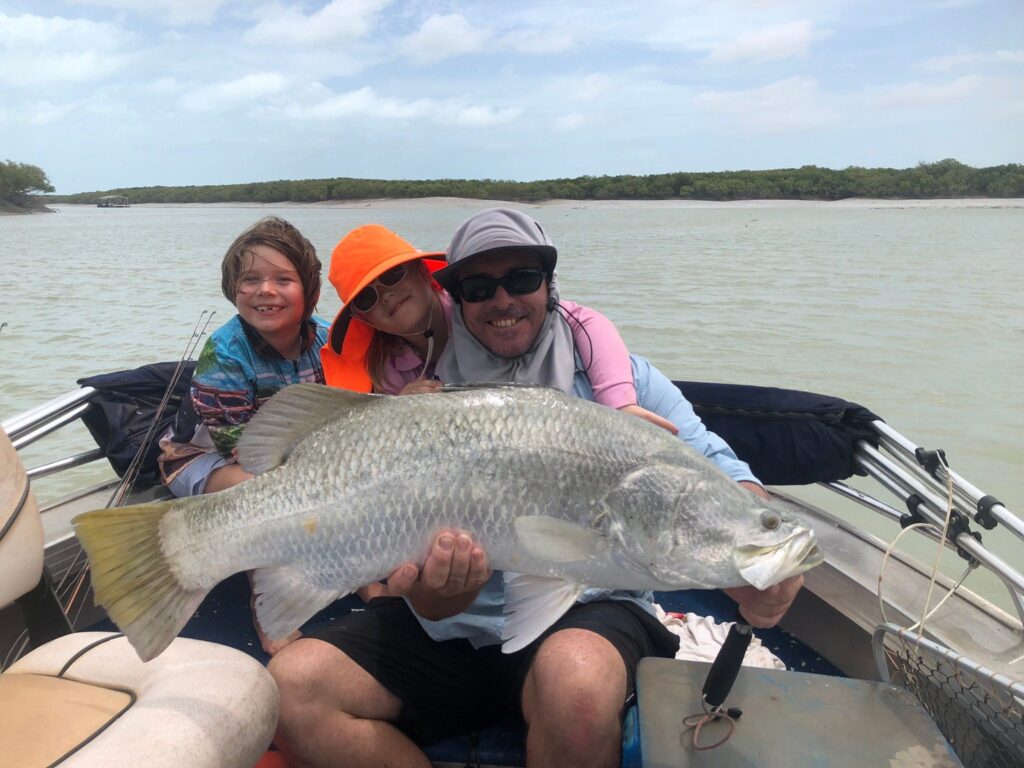
2. The Mary River (NT)
- The Mary River, snaking its way through the Northern Territory’s lush floodplains, is a legendary barramundi fishery. Renowned for its monster barra exceeding 25kg, the Mary offers a unique blend of challenging fishing and potential bragging rights.
- Prime Season: The river’s billabongs and estuaries offer plentiful opportunities, particularly during the run-off season from February to May when the barramundi are actively feeding.
- Fishing Grounds: Shady Camp, located 160 km south of Darwin, is the heart of the Mary River action and is famous for its massive barra. Barra can be found lurking near snags, rocks, and weed beds. Corroboree Billabong is another top location. Fishing charters offer guided excursions or alternatively a great way to experience the area is to hire a houseboat and/or fishing boat (as we did) and tackle the area yourself.
- Insider Tips: Be mindful of saltwater crocodiles that also call the Mary home, and practice safe fishing etiquette.
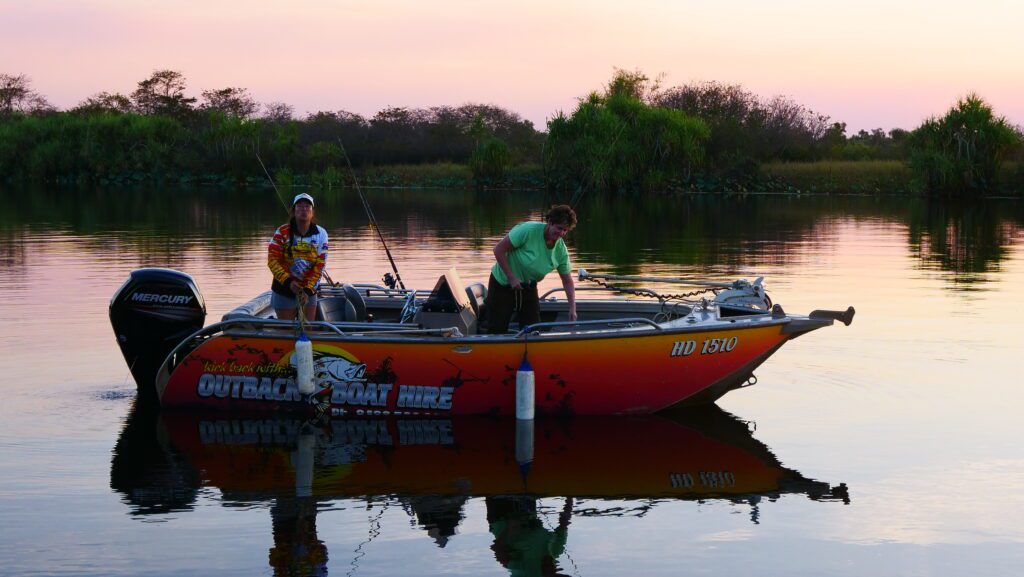
3. Dundee Beach (NT)
- One of our favourite NT locations, Dundee Beach, southwest of Darwin is a hotspot for barramundi fishing.
- Prime Season: Dundee offers multiple opportunities for barra and other species, therefore the sky is the limit in terms of the best season. For Barra always the hotter temps are the best.
- Fishing Grounds: The Finniss River, accessible by boat from Dundee Beach, is known for its large barramundi, especially during the run-off season. Anglers can enjoy both shore-based and boat fishing in this area, with excellent chances of landing a trophy-sized barramundi.
- Insider Tips: When we visit Dundee we always stay beachfront (incl. amazing food and an infinity pool) with Anglers Choice Safaris. Last trip we landed the Dundee trifecta – barra, jewfish, and sailfish in just two days.
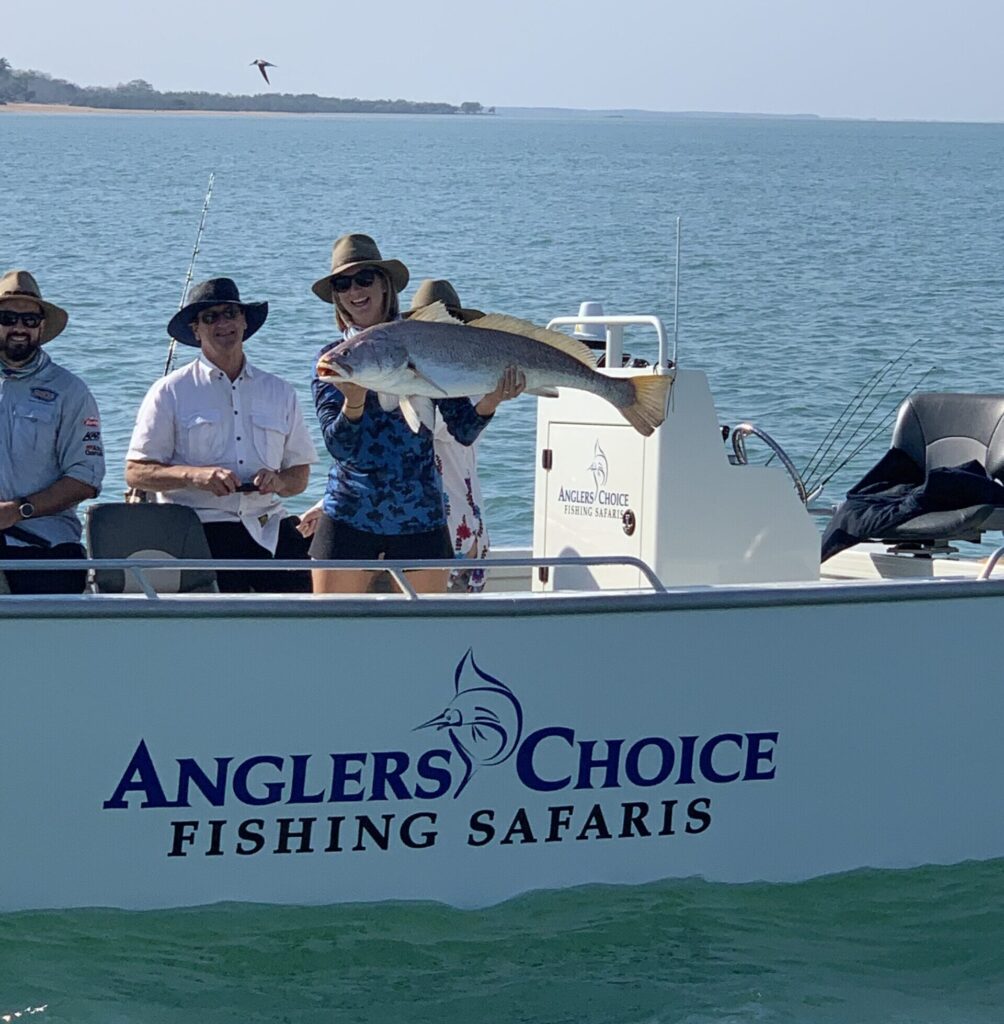
4. Darwin (NT)
If you only have a short period of time, helifishing in Darwin is THE BOMB. We had one of the best times of our lives! >> Watch our Darwin helifishing adventure here.
Alternatively, you can pop the boat in and go fishing at Shoal Bay. We went fishing for barra in Darwin with two of our Darwin students for a few hours and came up trumps. Best time to fish Shoal Bay is neaper tides. Also, a good area to fish in the dry.
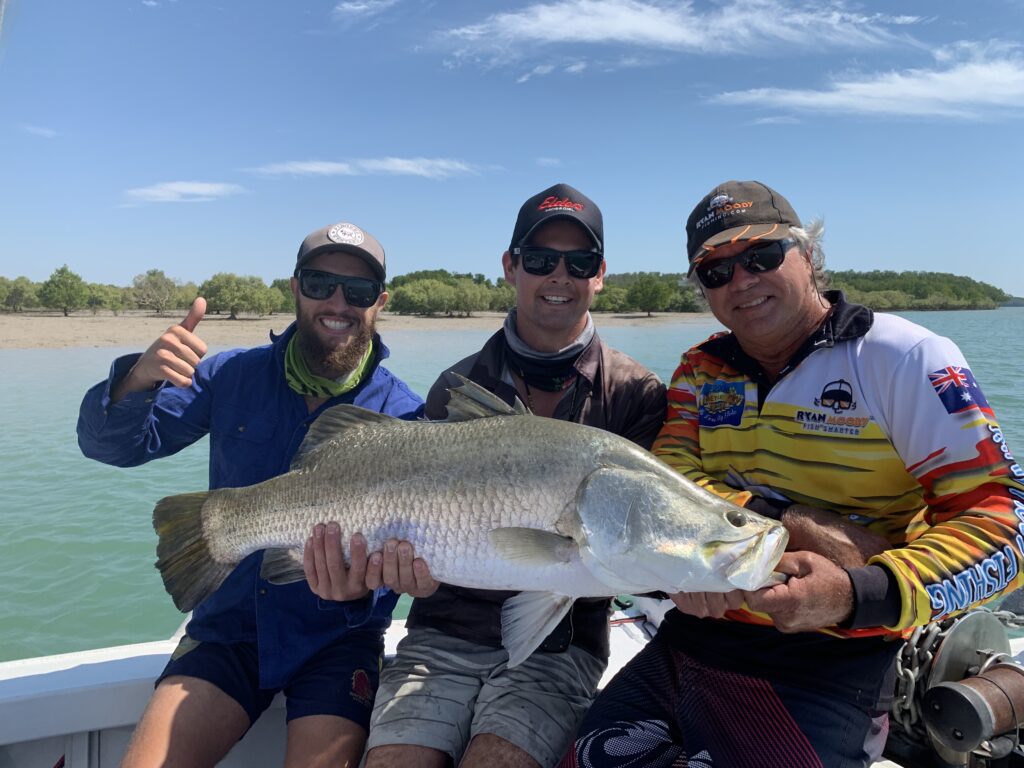
5. Hinchinbrook Island (North QLD)
- Hinchinbrook Island in North Queensland offers a unique barramundi fishing experience. The waters surrounding the island are rich in mangroves and estuaries, providing an ideal habitat for barramundi. I have caught over 1500 saltwater barra over a metre in this region over the years (watch our Big Barra series for a ton of them) and remains in my opinion, the most beautiful fishing destination to catch metre plus barra in Australia.
- Prime Season: October, February, March, and April are the prime times to hit Hinchinbrook. My brother, Ian Moody, takes barra charters in the area and can be contacted via his Ian Moody Sportsfishing Facebook Page.
- Fishing Grounds: The island’s sheltered creeks and bays are perfect for targeting large saltwater barramundi, particularly around Missionary Bay. Another hot spot is Hecate Point not far from the boat camp. It can be reached in a small boat but do watch the weather.
- Insider Tips: Big tides fish Missionary Bay. Small tides fish the channel.
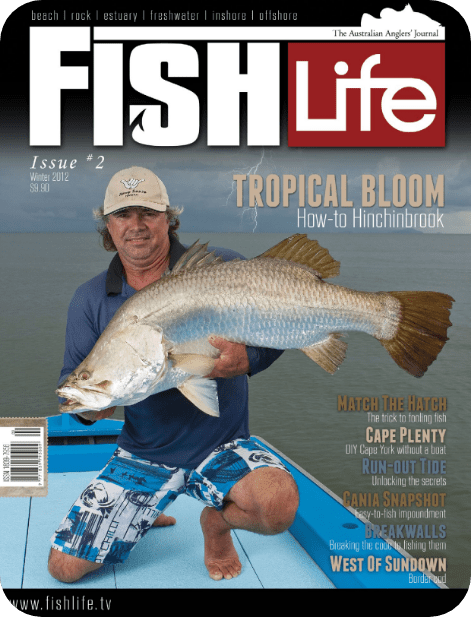
6. Rockhampton (Central QLD)
- Rockhampton, often referred to as the barramundi capital of Australia, offers numerous fishing spots along the Fitzroy River. The river is known for its healthy population of large barramundi, especially near the town of Rocky. The area has been a net-free zone for several years and the barra populations have exploded as a result. Grab a copy of the Fishing the Fitzroy booklet here.
- Prime Season: Prime season depends on rainfall in the catchment, as the Fitzroy River has a barrage holding water back into the dam. Release of water is critical to catches. However too much can result in weed and other debris making it hard to fish with lures.
- Fishing Grounds: The area has a diverse range of opportunities with Port Alma, the Fitzroy itself, Curtis Island, and the Casuarina area.
- Insider Tips: Neap tides are a better time for beginners due to the large tidal run. Snags, washouts, bridge pylons, and rocks are plentiful in this area and provide great barra habitat to target. The bridge pylons in town are known for capturing over 130 cm.
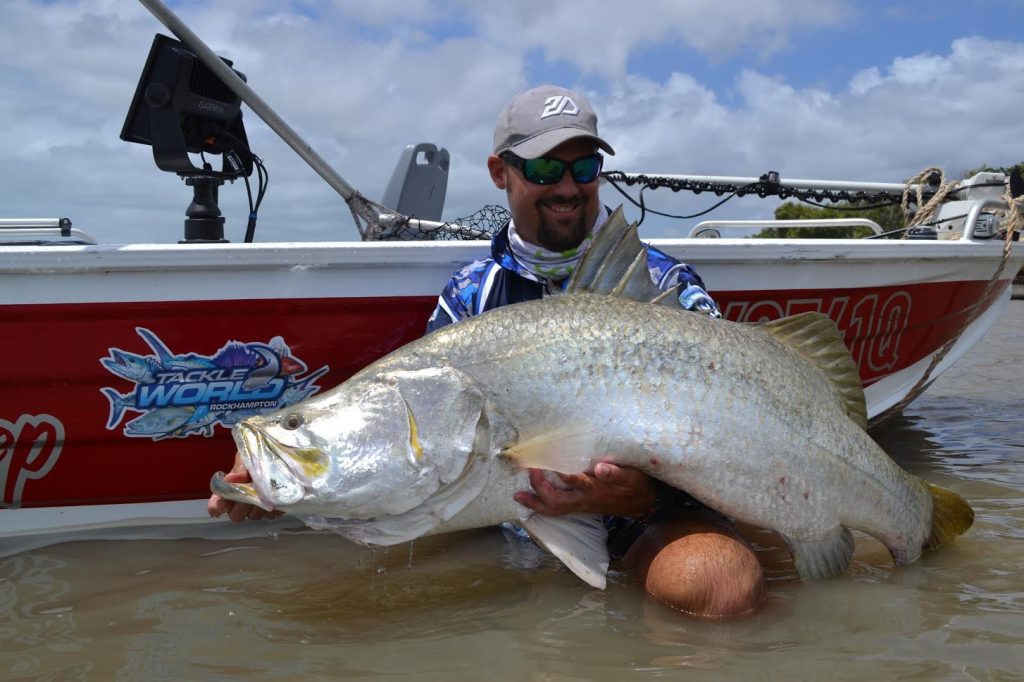
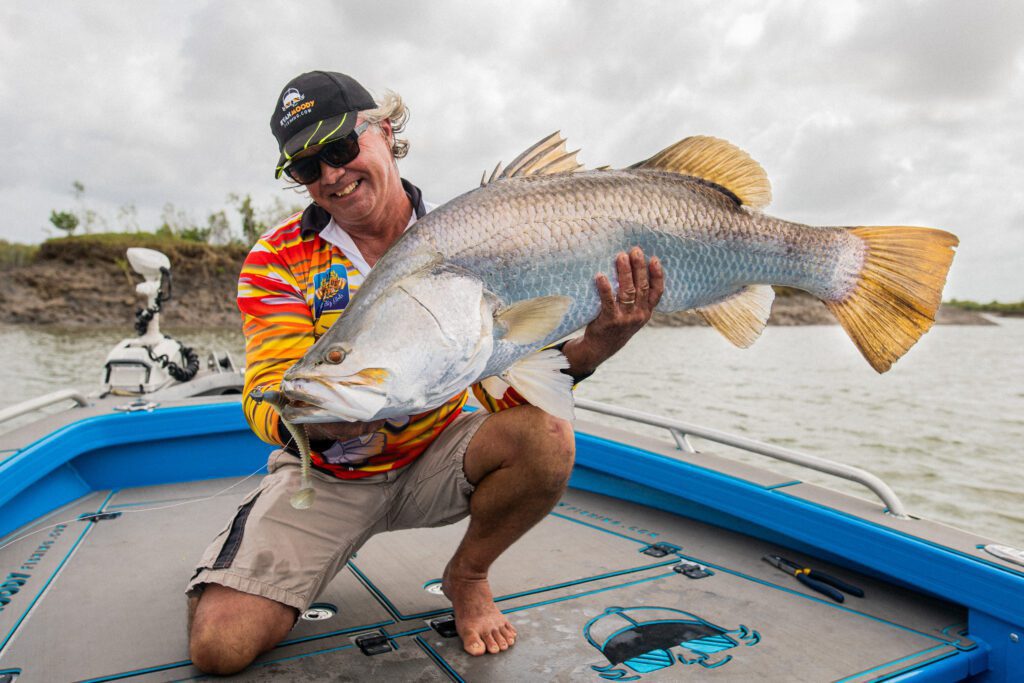
Lesser-Known Locations and Remote Spots to Catch Barramundi
Exploring lesser-known locations can often lead to more rewarding barramundi fishing experiences. These remote spots can be accessed via off-road vehicles or chartered boats. For anglers willing to venture further afield, the Gulf of Carpentaria offers pristine fishing environments with abundant barramundi.
Victoria River (NT)
The Victoria River in the Northern Territory is one of the lesser-known yet outstanding locations for saltwater barramundi fishing. The river is vast and offers numerous creeks and estuaries where barramundi thrive. Barramundi can be caught all year round but the best time is on a neap tide, between the months of March to late May – coinciding with the end of the run-off monsoon season when barra are actively feeding. Estuarine saltwater crocodiles inhabit the area in large numbers.
East Alligator River (NT)
The East Alligator River, located in Kakadu National Park, is another excellent spot for barramundi fishing. This river is known for its scenic beauty and abundant wildlife, including large saltwater barramundi. The downstream section of the river is ideal for barra fishing in the run-off season (February to April). As we have already explained, barra feeds actively when the gutters coming off the floodplain are running, as it’s an ambush point for baitfish.
Roper River (NT)
The Roper River is a remote and less-frequented location that offers exceptional barramundi fishing opportunities. The river flows through the Gulf of Carpentaria, providing a mix of fresh and saltwater habitats ideal for barramundi. The area is known for its large and aggressive barramundi, particularly around the river mouth and coastal estuaries.
Memorable Catches and Lessons Learned
After 30+ years as a barra fishing guide, it’s virtually impossible to highlight memorable catches, as every big barra for a client is a memorable day for me. I have an amazing memory and can look at any one of the photos and remember the location and sometimes even the client’s name.
I think this freaky memory and being an observational person, where I can also recall GPS marks by numbers, has enabled me to work out patterns that many people would struggle to work out.
If I could choose 4 or 5 memorable catches, they would be this.
1. The biggest saltwater barra on Australian TV
Fishing with Eddie Riddle filming his Fishin 4 wheels series in 2001, we caught a 131 cm barra (plus 5 more metries and several in the 80’s and 90’s) on film and you can watch all the 131 cm action here.
2. First barra (probably in the world) on braided fishing line.
Back in the day, I was working part-time in a tackle shop and the first braid to hit Queensland was called Triton Dyneema. We grabbed the first spool to hit the shelves and headed out after work.
It was an eye-opener. We picked up 3 Barras over 120 cm on lures in the first hour.
We could not believe the directness of the braid to the fish/lure. I could feel so much happening, feel when a fish had swiped at the lure and pushed it forward.
Things you cannot feel with monofilament. Hence we always use mono for bait fishing and braid for lures.
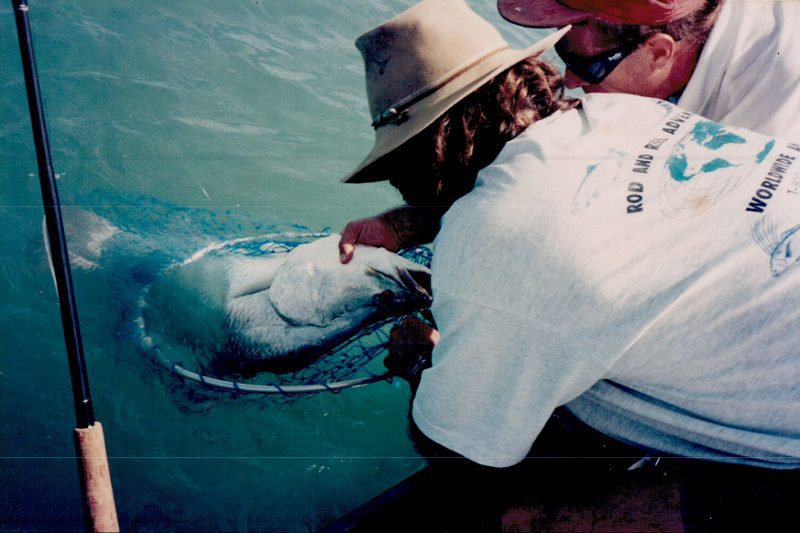
3. The “Jumper.”
Back in the day, I was always testing new techniques and on this day we were bouncing deep diving lures over shallow rock bars, trying out a new theory. This was long before soft plastic lures were invented.
Within minutes, a 117 cm fish grabbed the lure and did three consecutive jumps, every one of them 2.5 metres out of the water. I’ve never seen anything like it.
I still talk about it with my mate Ruffy today. It was like a bloody marlin haha.
4. The “Tailgate.”
When we first released Barra Basics back in 2014, many of our students went straight out and caught metre plus barra. The community that has grown up around us as a result of that course is nothing short of remarkable. Here are just a few of the catches from students.
Anyhow not long after I was sent this photo from a mate who found a car parked in Townsville. Turns out it is owned by one of our first students, Bevan.
Gotta be proud when someone thinks enough of your course to make a giant sticker for their tailgate. Thanks for doing that if you read this Bevan. A real highlight.
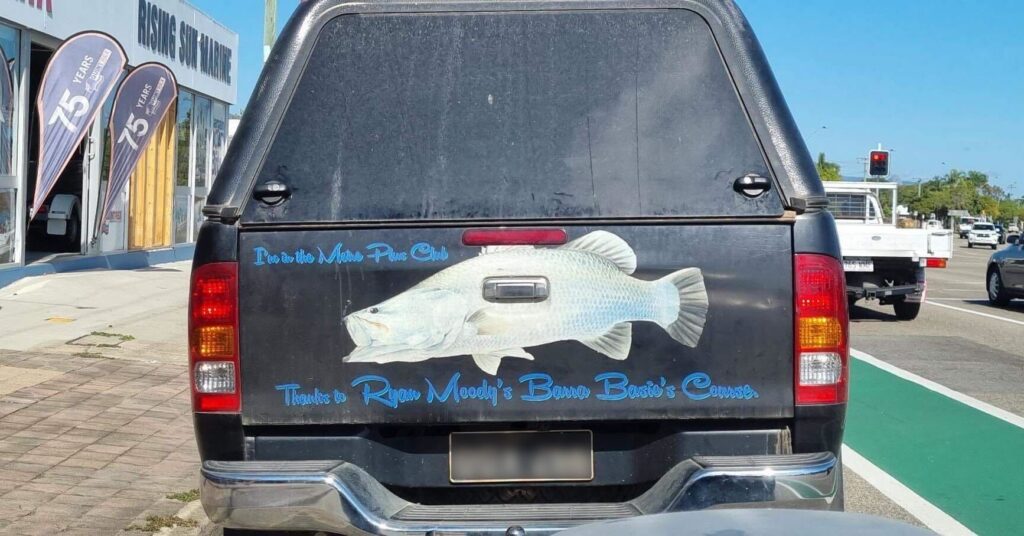
5. The 2000th Barra (makin’ the news)
In 2016 after months of sitting on 1999 and catching a score of 90-99 cm fish, I finally cracked the 2000th saltwater metrey after 30 years in fishing charters. In doing so we made the paper and the nightly news. I don’t think I’ll live to get 3000. But hey, 2000 is enough.
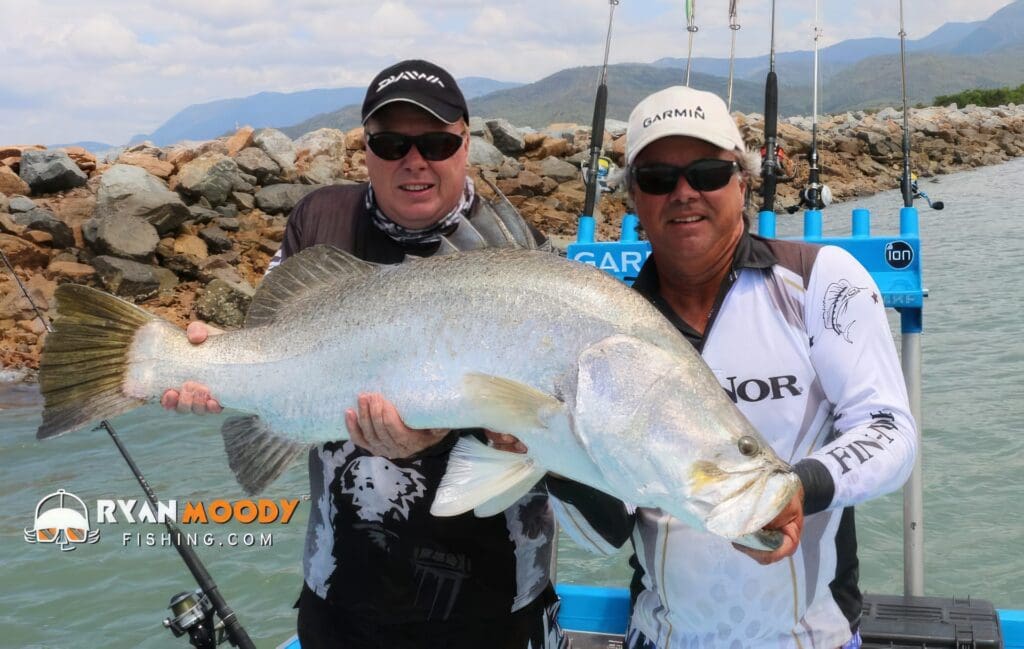
Popular Dams for Freshwater Barramundi
Freshwater barramundi fishing in Australia offers a unique and exciting experience for anglers.
As mentioned earlier, some purists may argue that catching barramundi in dams is less challenging than in the wild and freshwater Barramundi don’t hold the same iconic status, but the experience can still be incredibly rewarding.
Dams provide a controlled environment where barramundi are often more abundant and easier to locate, making it a great option for both novice and seasoned anglers.
This chapter will guide you through some of the top dams for freshwater barramundi fishing, as well as insights into lesser-known locations.
Top Freshwater Barramundi Fishing Dams
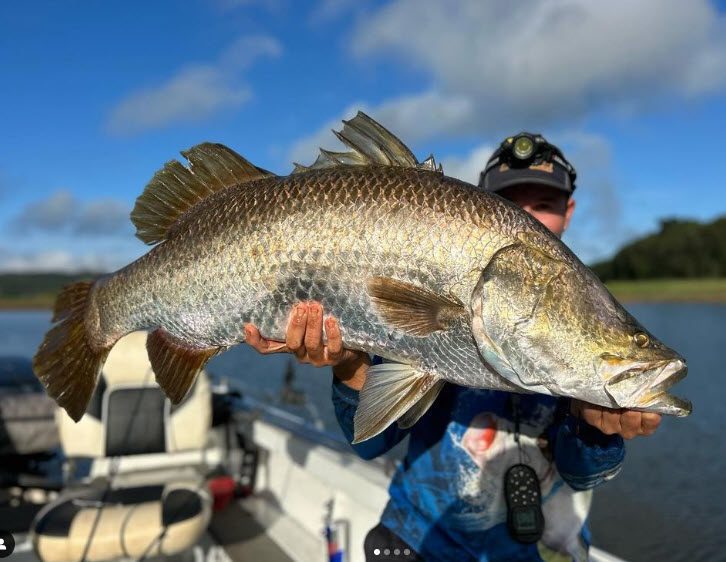
Tinaroo Dam (QLD)
Located on the Atherton Tablelands in Far North Queensland, Tinaroo Dam is one of the most famous destinations for freshwater barramundi fishing. The dam is known for producing record-sized barramundi, with many catches exceeding the one-metre mark. Our youngest student Jack Centofanti (find him and his catches on insta here) has caught hundreds of big barra on this dam with the help of our course Barra Basics. Tinaroo’s extensive weed beds, submerged trees, and rocky outcrops provide an ideal habitat for barramundi, particularly during the warm periods when barramundi are most active.
Awoonga Dam (QLD)
Awoonga Dam, near Gladstone in Queensland, is another premier spot for freshwater barramundi fishing. The dam is regularly stocked with barramundi, and it’s not uncommon to catch fish over 120 cm. The best fishing occurs during the early morning and late afternoon, especially around the shallow bays and points where barramundi tends to hunt for food.
Kinchant Dam (QLD)
Kinchant Dam, located near Mackay in Queensland, is renowned for its large barramundi population. The dam features an abundance of weed beds and submerged timber, making it an ideal environment for barramundi. Night fishing can be particularly productive in Kinchant Dam, with anglers often using surface lures to entice big barramundi.
Peter Faust Dam (QLD)
Peter Faust Dam, also known as Lake Proserpine, is situated near Proserpine in Queensland. This dam is famous for its trophy-sized barramundi, with numerous catches reported over the magical one-meter mark. Fishing is best during the warmer time of year. Most anglers say the weed edges and timbered areas are prime spots to target. However, I prefer to fish in more open areas as we explained in our course Barra Basics. The dam’s clear water allows for sight fishing, adding additional excitement. My mate Luke Fallon runs guided barra tours – tell him I sent you. Or you can just catch a metrey off the boat ramp.
Lake Monduran (QLD)
Lake Monduran, near Gin Gin in Queensland, is a popular destination for anglers chasing big barramundi. The lake is well-stocked and has a reputation for producing large fish, especially during the warmer months. Key areas to focus on include the shallow bays and submerged timber where barramundi are often found ambushing prey.
Lesser-Known, and Remote Dams and Reservoirs
While the above dams are well-known, some several lesser-known dams and reservoirs also offer excellent freshwater barramundi fishing. Accessing these remote spots often requires local knowledge and a willingness to explore off-the-beaten-path locations.
Manton Dam (NT)
Manton Dam, situated about 70 kilometers south of Darwin, is a lesser-known but excellent location for freshwater barramundi fishing in the Northern Territory. The dam is easily accessible and offers good opportunities for catching barramundi, particularly during the warmer months. The presence of weed beds and submerged timber makes it an ideal habitat for barramundi.
Lake Lenthalls (QLD)
Lake Lenthalls, near Hervey Bay in Queensland, is a lesser-known gem for barramundi fishing. The lake is well-stocked and offers a peaceful fishing experience away from the more crowded spots. The best fishing areas are near the shallow bays and weeds, where barramundi are often found lurking. Early morning and late afternoon are the most productive times to fish here.
Teemburra Dam (QLD)
Teemburra Dam, located near Mackay in Queensland, is another excellent spot for freshwater barramundi fishing. The dam features a variety of habitats, including submerged timber and weeds, which are ideal for barramundi. Anglers have reported success using both live bait and artificial lures. Night fishing is particularly effective at Teemburra Dam, with many large barramundi caught during the night.
Memorable Catches in Impoundments and Lessons Learned
Most of my Barra fishing has been in the saltwater reaches of estuaries, however I have done a bit of time in the impoundments. Especially in the early days of restocking. My barra basics course has a specialised impoundment framework and many of our students are doing very well. As far as memorable catches for me, two come to mind.
1. What a wonderful wife.
This one was caught while filming the barra basics (weeds) segment of our impoundment module – when the big girl got tangled in the weeds. Well, we always catch a good fish in each of our demo videos and Karen was not letting this one get away without a photo. THAT is a memorable catch. Watch the video to see my wonderful wife taking it to the next level.
2. Big Barra at the boat ramp.
In early November a few years ago, I was asked to commentate at the Australian Fishing Championship at Proserpine Dam, and to be honest, had just come off a string of charters and had no intention of fishing haha.
As the following video (which has gone a bit viral on Facebook) shows, you certainly don’t need to fish in the timber to catch giant barra.
Once I knew the fish was there and within casting distance, all I needed was a lure of the right depth and style to run right past her.
I borrowed a rod from the AFC camera vessel, realizing straight away the lure on it was a bit heavy (it was a big stick rig with a heavy jig head for deep jigging) but gave it a go anyway.
Holding the rod as high above my head as I could, I tried to get it into the right position, but using the slow retrieve I needed to attract a bite, the lure was just too heavy.
I really needed something lighter and remembered a couple of lures were sitting on the dashboard of the boat.
After gnawing through the leader and leaving the old knot attached (no clippers in sight), I tied on a Keitech 5.8 Swing Impact Fat which could be retrieved slowly and still stay above the fish. Perfect.
Two casts with the Keitech (albeit a left-handed rod which felt a bit strange) and I had her.
Interestingly one of our recent blog posts features these soft plastic lures including some underwater footage of the action. Click the following link for some techniques when using soft plastics and swim baits.
Gear and Tackle Recommendations
When preparing for a barramundi fishing trip, having the right gear and tackle is crucial for success. This chapter provides a comprehensive list of recommended equipment. Additionally, we discuss the best bait and lures for barramundi, discussing their pros and cons, and what works best in various conditions.
Comprehensive List of Recommended Gear
Rods:
Rod selection will depend on whether you are live baiting, lure casting, or jigging. We have listed likely outfits in our gear and tackle cheat sheet. In short… Graphite/graphite composite rods for all lure work because you need directness when the fish hits a retrieved lure. Live baiting is more passive (relying on the fish to hook up yourself) so we need to stretch. See our blog mono vs braid for barra fishing.
- Live Baiting: We prefer to use 6’6″ fibreglass rods in an 8-10kg blank with a soft tip with a monofilament line.
- Lure Casting: 5’6″ to 6’0″ graphite or graphite composite blank in the 8-10 kg range with braided line.
- Jigging: 6’0″ to 7’0″ jig/spin blank made of graphite composite or nano carbon in the 8-10 kg range with braided line.
Reels:
- Spinning Reels: Spinning reels are typically used for live baiting and jigging where a better retrieve rate is required. Reels in the 4000 size for jigging and 6000-7000 size range are best for live baiting. We have a blog on barra gear selection here. If you are going to use a spinning reel, be sure and take note of this tip to avoid line twist. By casting overhead you can reduce the dangers of hooking others and get more accuracy from your spinning reel.
- Baitcasting Reels: For more experienced anglers, baitcasting reels offer better control and accuracy when lure casting hard bodies into tight areas –> Baitcaster avoiding birds nest tips. Baitcasters come in similar sizes for different brands. So it comes down to budget and personal preference. This is where you’re better off heading to a tackle shop for advice or checking out our gear and tackle cheat sheet.
Here’s a general comparison between Spinning Reels VS Baitcaster Reels for Lure Casting. That said you can catch pretty big fish on kids’ rod and reel combos but I don’t recommend it as a regular practice.
Lines:
The following recommendations are only applicable if you have the correct drag settings and have a smooth well-maintained drag. We also suggest washing your reel and drag correctly to ensure
- Braided Line (lures only): A braided line around 20lb is preferred for its low stretch, which is essential for feeling your lure’s action and any sideswipes or swim forward strikes of barramundi. Most brands have an 8-strand (around PE 2) that will suffice.
- Mono Line (live bait only): 10 kg mono is best and will land most fish – if drag is set correctly.
- Leader Line: A good quality fluorocarbon leader in the 60lb range will suffice but I prefer to use Ande for its durability and flexibility. It is imperative that you use the wind-on leader system and a longer (6-foot) leader line length when fishing around snags and structures.
The best way to set up your line is using the wind-on leader system, which ensures a smooth transition between your main line and the leader. This system reduces the risk of weak knots and allows for quick changes in leaders in the field. You can find more about the nine leader line myths and best leader line length here!
Rigs:
- Paternoster Rig: Effective for bait fishing in deeper water, this rig helps keep the bait off the bottom and away from snags. It is also very useful when land-based and fishing around rocks –> How To Tie A Paternoster Rig!
- Running Sinker Rig: This rig allows the bait to move naturally with the current, but only in an open shallow country with tidal movement. Learn about why this is so and how to tie them –> How (and why) To Tie Running Rigs!
Hooks:
There are many different hook types on the market to choose from. But the best hooks to use for Barramundi fishing are the following:
- Kahle Pattern Hooks: The Kahle pattern has been my go-to hooks for live baiting and is excellent for catch-and-release fishing as they reduce gut hooking. I love them so much that when they became in short supply I decided to import my own and call them Kahle Pattern Jaw Jerkers haha –> We supply them in 6/0 and 7/0 which are the two most popular sizes for barra fishing.
Best Bait for Barramundi Fishing
Live Bait: Live bait is often considered the best option for catching barramundi. The natural movement and scent of live bait such as mullet, herring, prawns, gar, and whiting (legal size) are highly attractive to barramundi.
Live mullet, in particular, is a favourite among anglers and can be found in various locations –> Tips for catching mullet around creek mouths. It is imperative that your baits do not spin in the current. We provide some advice on pinning live bait effectively here.
Using the Paternoster Rig, to keep livies from swimming into snags and keep them just above the bottom (barra have eyes on the top of their head). Prawns are the best live bait in winter 100 percent.
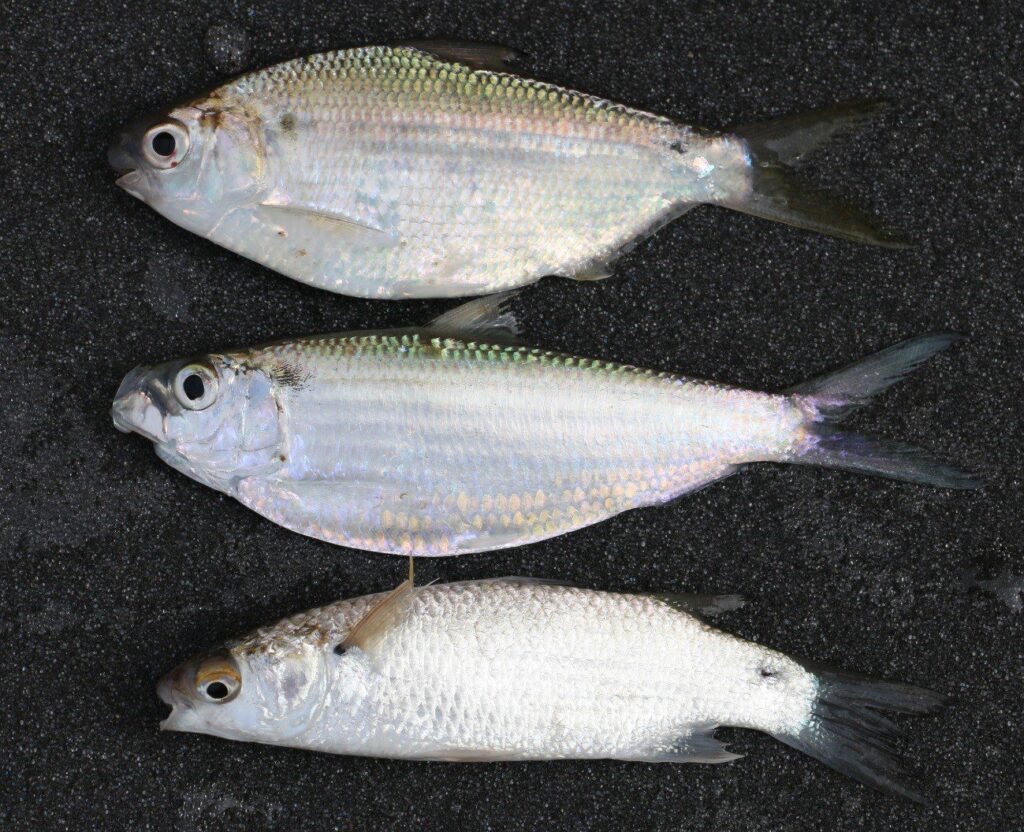
Dead Bait: I never use Dead bait, however, I have heard of metre barra being caught on strip baits and prawn heads. Some people get lucky I guess. Your best bet is to learn to catch live bait. Our Locating Livies course will have you catching Livies quickly and easily and you’ll never buy bait again!
Pros and Cons of Live Bait:
- Best Conditions: Bait is most effective in murky or heavily fished waters where barramundi rely on vibrations to find their prey.
- Advantages: Live bait is particularly useful when barramundi are not actively hunting, hence it is the most successful all-round method for nailing barra.
- Disadvantages: Live Bait is more likely to attract non-target species like sharks or catfish than lures. Furthermore catching live bait can be time-consuming. You really need to catch them before the bite period as the last thing you want to be chasing when the time is right is your bait! High tide is particularly troublesome for some people. On charter, I had to catch bait every single morning no matter the conditions, hence having a good arsenal of knowledge is imperative for a successful outing. Knowing how to locate them, to be able to catch them on the go is key –> Learn how!
Best Lures for Barramundi Fishing
Shallow Diving Hard Body Lures: My favourite way to catch barramundi is in shallow feeding situations where they smash the lures from below. Slow-rolling minnow-style lures like our Scaleblazer 125 are particularly effective on larger fish. Old Dog Lures Guttermaster works well for smaller fish in the drains. Rapala X-Rap (shallow diver) can also be used for this purpose.
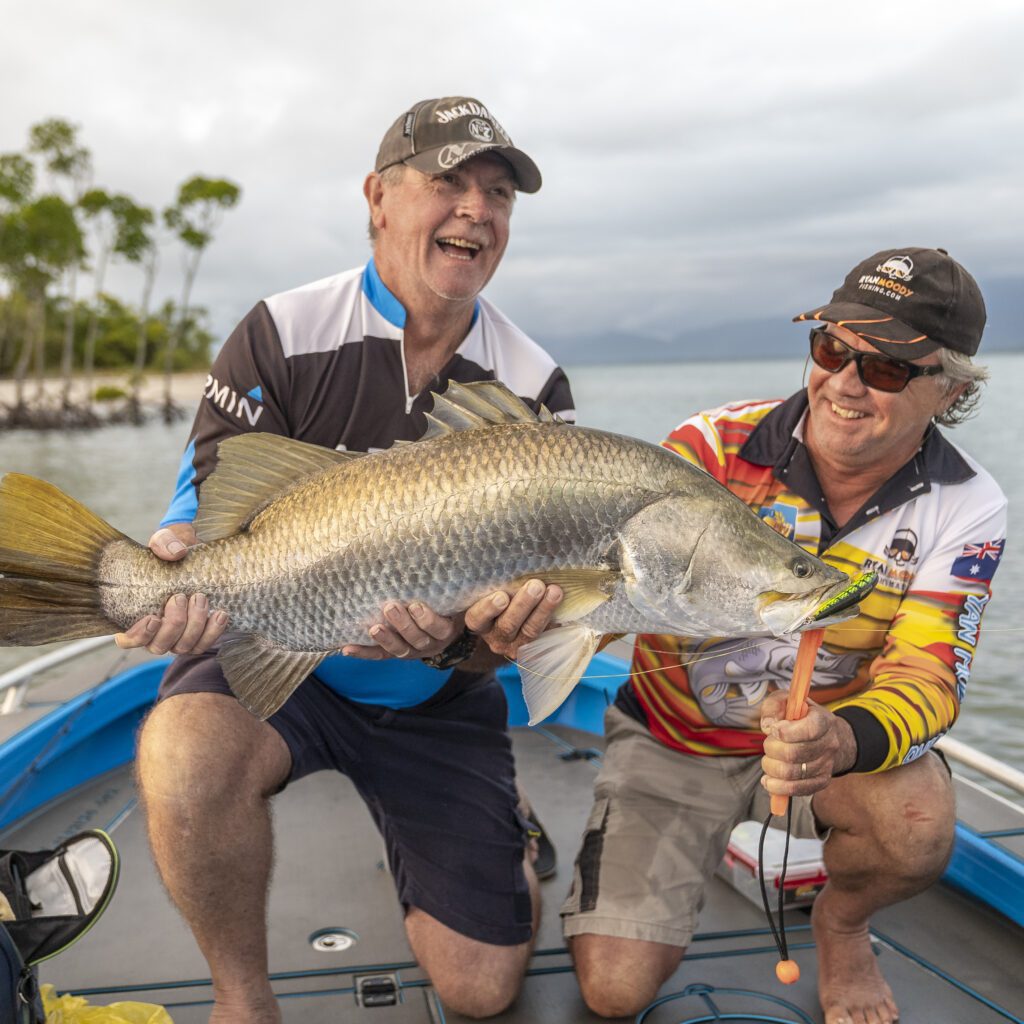
Soft Plastics: Lightweight (1/4 oz) jig heads or weedless is the go when working lures just under the surface> For example in dams around the weeds or shallow water snags. Paddle tail plastics have accounted for many good fish, but be mindful that you need to get the weights right about both depth and current. –> Tips for fishing with soft plastics – choosing the right one.
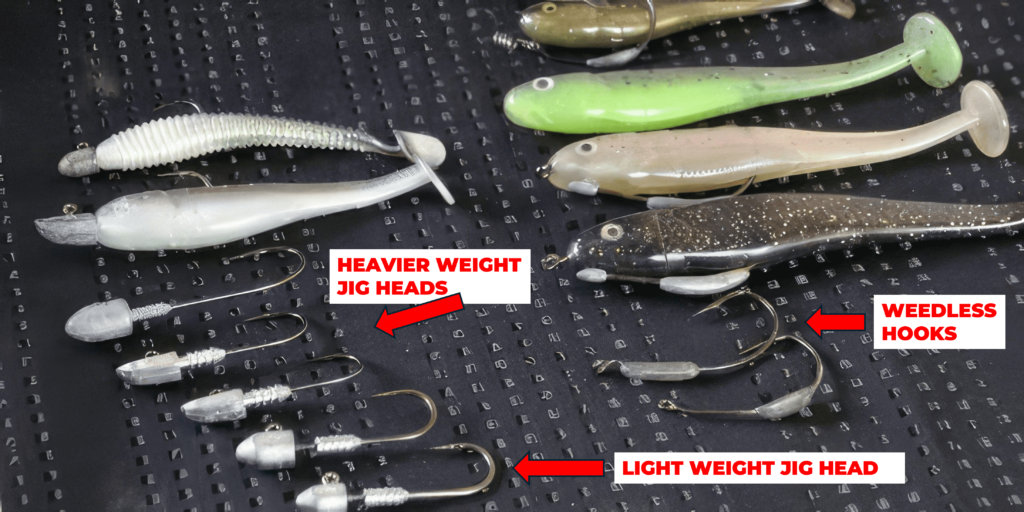
Vibes and Sinking Stick Baits: I used to solely use vibes for deep water jigging, but in recent years I’ve started using sinking stick baits.
These are dynamite due to the extra action on the fall (vibes vibrate on the lift). It’s in the fall that most fish hit so the fluttery action on the fall is irresistible to most barra.
We have had such success I now stock them under my own brand. –> Buy Pillager sinking stick baits. As part of the purchase, we provide a video on the best action to use them. They are also dynamite on many other species like the Fingermark (Golden Snapper) below.
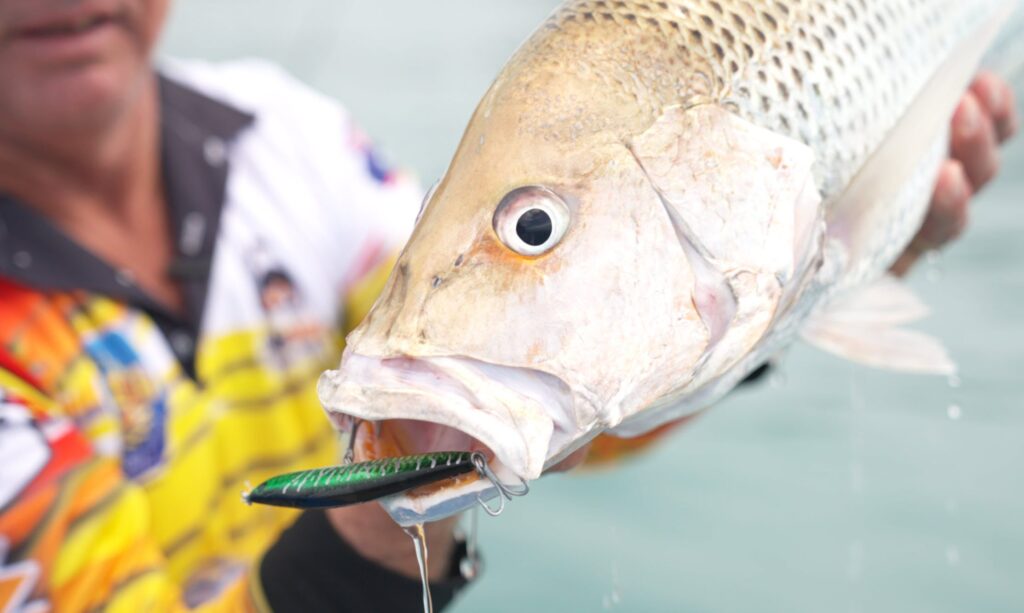
Trolling Deep Divers: Trolling deep divers can work when they refuse to take jigged lures. My go-to is the RMG Scorpion (5-8 metres). You must get the lure in front of the fish so be mindful to watch your depth when trolling. Having a few different depth lures is beneficial and one trick is to raise or lower your rod tip to raise or lower your lure or vary the length behind the boat.
Our in-depth blog offers a detailed breakdown of the 7 Best Barramundi Lures.
Pros and Cons of Lures:
- Best Conditions: Barramundi prefer to hunt in cloudy or dirty water so lures with a good contrast (stripes) and/or vibrations/rattle are most effective.
- Advantages: Lures are immediately useable and you don’t have to worry about catching livies and keeping them alive. They are particularly effective when barramundi are actively feeding.
- Disadvantages: Using lures requires more skill and experience and can get expensive when you lose them –> Best way to get lures off snags!
For a comprehensive info sheet on everything you need for barramundi fishing, download our free Gear and Tackle Cheat Sheet. It’s packed with all the essential information for your next Barramundi fishing trip!
Fishing Techniques for Catching Barramundi
Now that we’ve covered the essential aspects of barramundi fishing it’s time to bring everything together. This chapter provides a step-by-step guide to effective fishing techniques for barramundi.
How to read the water and understand barramundi behaviour
1. Reading the Water:
- Surface Activity: Look for signs of baitfish activity, such as pop-eye mullet or ripples on the water surface indicating herring. I learned a lot about barramundi patterns by learning where and how to catch bait.
- Water Clarity: If you are going to fish in clear water, be very quiet and give yourself plenty of distance between yourself and the fish as they are quite timid in clear water. In murky water, opt for bright or contrasting colors and lures that produce vibrations.
- Structure (Rock Walls): Rock walls can be very effective places to chase barra both land-based and in a boat. Cast lures along the wall rather than directly out as most fish will be tight in close to the structures. Barramundi uses these structures for ambush points.
- Structure (Snags): Work the edges of snags and sometimes let the lure suspend as it goes past momentarily. For live bait fishing, position your bait on the up-current side. If you don’t have an electric motor you can use the twin anchor technique.
- Open Water and Current Collisions: People may be surprised to discover that I chase most of my huge barra in open water away from snags and other obstructions. They are much easier for inexperienced anglers to catch in these areas which were great for my charter days. These areas appear at certain times and wind directions, often quite unpredictably. I cover finding and working these areas in our course Barra Basics.
2. Understanding Barramundi Behaviour:
- Feeding Patterns: Barramundi are opportunistic feeders and often ambush their prey. During ebb tides, barra will move to areas where the bait is funneled (drains and gutters are one example). In these areas, they can hide and strike unsuspecting baitfish as they move out. During the run-off season, they congregate around river mouths and estuaries to feed on the influx of baitfish.
- Tidal Influence: Barramundi are highly influenced by tides. They like to make their way into the shallows with the tide to hunt. When the tide is high they are often in areas very hard to reach.
- Temperature: Barramundi are more active in warmer water temperatures (above 24°C). During colder months, they tend to be less active and seek deeper, warmer waters. This creates an advantage (see our barra strategies workshop) to find aggregations that you can target when the water warms.
4 Essential Tips to Help You Catch Barramundi
By understanding these habitat and behaviour characteristics and using the right techniques, you can significantly improve your success rate. Here’s a concise guide about the right techniques to get you started:
1. Live Baiting
Live baiting is a highly effective method for catching barramundi due to their opportunistic feeding habits. Here’s how to make the most of this technique:
- Strategy: Cast your live bait (paternoster rig) to the up-current structure. This allows the fish to come to you and clear the snag when they inhale the bait. It’s a common misconception that barra are dirty fighters. Most times they will head for open water and if you get snagged it’s because the snag was in the way. I leave my live bait rods in the holder and do not strike. Let the Kahle hook do the work! Patience can be key on days when they are upset by weather changes.
- Effective Areas: Cast near snags, drop-offs, submerged vegetation, and around mangroves. These are typical hunting grounds for barramundi, as they use these structures to hide and strike unsuspecting prey.
2. Lure Fishing/Casting
Lure fishing is an active and engaging method for targeting barramundi.
- Strategy: Cast lures accurately and close to structures like mangroves, headlands and rocks where funneling locations exist. Or in some cases open water areas where currents direct bait fish into areas where they can be ambushed from below. Our Scaleblazer is a tried and proven casting lure for Barra. –> Buy Scaleblazer here.
- Casting Technique: Vary your retrieval speeds and actions to mimic the erratic movement of injured prey. E.g. A steady slow roll, twitching the lure to create sudden movements, then pausing to trigger strikes during the stop. The method of retrieving a lure will depend on whether the fish is agile and active, or dormant and holed up. When active you can pretty much throw anything at them and they will have a crack. When dormant you need to resort to trial and error. One example is changing casting angles. Experiment with these methods to find what works best under the current conditions.
- Jigging Technique: Jigging is a deeper method of lure fishing where you have to entice fish into slumber mode. E.g. not actively feeding. This all comes down to critical positioning, sounder observation while on the spot, and the direction you retrieve past the fish. We recommend you get up to speed on your fish finder skills. We have three options 1. FREE Big Picture Presentation. 2. Sounder Skills 1 is currently 60% off only $20 AUD and 3. Our comprehensive course is Sounder Skills 2 (every angler should do this course!).
3. Trolling
Trolling is an excellent method for covering large areas of water and locating active barramundi. However, I see many people wasting time and fuel trolling when they should be sitting in a funneling location.
My use of trolling is far more selective, and I mostly only use it when fish rise up at a certain part of the tide. It’s not something I do for hours and hours.
- Strategy: When you see the fish rise from slumber mode, make multiple passes over hotspots to cover the area thoroughly. Vary the depth of your lures to target the exact depth where barramundi are showing. I can’t stress enough the importance of knowing your fish-finding equipment. If you haven’t already, sign up for our Big Picture Sounder presentation below.
- Trolling Technique: Maintain a consistent trolling speed between 2-3 knots, depending on the day and how the fish are reacting. It’s imperative you’re lure is passing just above the fish. You can do this via raising your rod top, speed of the boat, or lengthening/shortening the line. Lengthening the distance makes the lure swim deeper. A rule of thumb is 3x the depth of the lure behind the boat. e.g. troll a 5-metre diver 15 metres back and it should be swimming near the depth capability (5m) of the lure.
NOTE: Ensure the lures are swimming naturally
Always test and adjust the tow points if they swim to one side (if swimming left, adjust the two point with pliers to the left). One issue I regularly see is anglers using the incorrect depth lure as they have not pinpointed the fish depth correctly using their sounder. Experimenting with this is why I catch half a dozen fish in the same location as other anglers catching one.
- Route Planning: Create a trolling route that maximises your time on the school – unless they spread out which is when your side imager comes in – to adjust your route to run over them again. Use an oval pattern and go past them enough to get my lures to the correct depth after turning to be back on the fish.
- Demonstration: On one of our trips in Port Clinton (Central Queensland), we used the trolling technique as a last resort when everything else didn’t work in these harsh conditions –> Watch us trolling for Barra!
4. Jigging
Jigging is particularly effective when targeting barramundi holding close to the bottom or tight to the structure. It offers a great alternative to trolling as you are keeping the lures down there longer next to the school of fish, not relying on one crack every pass. I mostly jig when the run is quieter and the fish are aggregated.
- Strategy: Focus on areas with significant underwater structures where barramundi are showing on your sounder. Drop the jig directly down to the structure and work it up and down within the strike zone. Pay close attention to the lure on the drop, as many strikes occur when the lure is falling.
- Locating: Use a depth sounder to identify underwater structures and schools of fish. This is key for locating barramundi in deeper waters. Look for areas with submerged trees, rock bars, and drop-offs, which are prime spots. If you’re unfamiliar with using a depth sounder, consider taking a look at our sounder skills course to improve your ability to locate fish accurately.
- Technique: Experiment with your jigging motion and the rate of fall of your vibe/stickbait or plastic in relation to the current. It’s imperative you get to the fish (mostly on the bottom in these instances). Work the lure vertically off the bottom using your rod tip. Vary the speed of rise to experiment with trigger points. On the fall try not to remain tight to your lure or you will inhibit the fall rate or vibration/action. We provide instructions on how best to use our lures after purchase. Our Pillager is a great option for jigging barramundi –> Buy Pillagers here.
- Timing and Conditions: Jigging is particularly effective in deeper waters or during slack tides when barramundi are less active in shallower areas. Adjust the weight of your jig to match the depth and current conditions, ensuring it stays close to the bottom where barramundi are hunting.
FISH FINDER FREQUENCY FOR CHASING BARRA
If you don’t understand your sounder and use the right frequency, you’re going to make seeing a fish a whole lot harder!
The various modes will also throw illusions at you which can trick the uninitiated. One example is using the wrong range and boat speed simultaneously, so you won’t know the size of the fish, or the exact depth/location. Barra is lazy most of the time and if you are not spot on, you won’t get a hit.
Even identifying fish as barra can be a challenge unless your unit is set up perfectly. You can easily make small fish look big and vice versa. It really is an art and the most important thing contributing to my success.
When I started I had an old Marinetec Seamax and caught plenty of fish. So don’t be dismayed if you are using an older unit. Sure all the whizz-bang features look appealing. But I prefer a simpler approach. If you remove the illusions (or at least understand them) you’ll work out what is actually under you. This is 95% of the battle won.
Catch and Release Best Practices
Sustainable fishing practices are crucial for maintaining healthy fish populations and ecosystems. For barramundi, catch and release is a vital component of conservation efforts. By practising catch and release, anglers contribute to the preservation of barramundi populations. Hence ensuring that future generations can also enjoy this exhilarating fishing experience.
Catch and release helps to:
- Maintain barramundi populations by allowing mature fish to continue breeding.
- Reduce the impact on local ecosystems by minimizing fish mortality.
- Promote a culture of conservation and responsible fishing within the angling community.
The following are a few best practices for Barramundi Catch and Release:
Minimise Time Out of Water
- Quick Handling: Minimise the time barramundi spend out of the water. I know that taking a photo of your catch is an essential part of the fishing experience. But it must be done quickly and efficiently to reduce stress, and potential injury and to ensure the fish’s survival. This is why I stopped tagging fish in the early days. I’d have two anglers on and two fish already on the deck and just didn’t have time to measure and tag without risking fish wellbeing. It’s also why I don’t use a net. The lure/hooks get tangled in it and make the release a longer process. I can comfortably hold a fish into the boat, remove hooks, photograph it, and get it back into the water in under a minute.
- Wet Hands and Surfaces: Always wet your hands before handling barramundi to protect their slime coating, which is essential for their health. Use a wet cloth or landing mat to avoid contact with dry & hot surfaces. Reminder, a burning hot aluminium tinny surface that will fry an egg is not a good place for a barra! That said barra are very hardy in comparison to Threadfin Salmon.
Support the Fish Properly
- Horizontal Support: ALWAYS support the fish’s weight horizontally using both hands. DO NOT hold the fish vertically by its gills, as this can cause internal injuries and stress. They just do not have the musculature and structure to support their weight by hanging from the head unless they are very small.
- Avoid Touching Sensitive Areas: Do not touch the fish’s eyes or gills, as these are very sensitive and can be easily damaged.
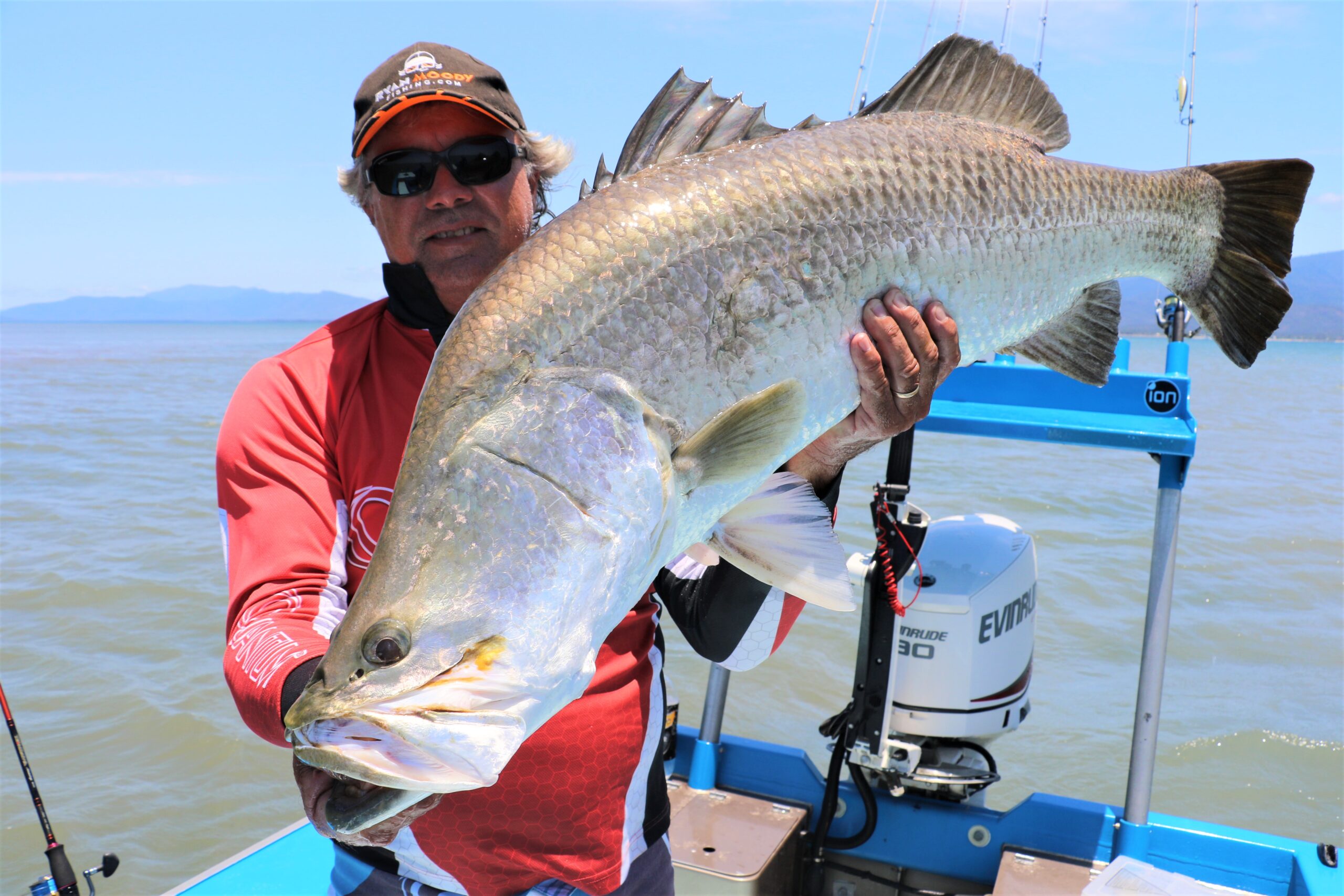
Use Appropriate Gear
- Knotless Landing Nets: If you’re not familiar with proper lifting & holding techniques I recommend using a soft, knotless landing net to minimize the loss of protective slime and scales. This increases the fish’s chance of post-release survival.
- Barbless Hooks: If you are traveling remotely or are worried about hooks, please use barbless hooks or debarb your hooks to make them easier to remove. This will reduce injury to the fish and yourself –> How to crimp barbed hooks! I personally don’t crimp or use barbless unless I’m going remote. You will jump fish off barbless hooks more often than barbed for obvious reasons.
- Long Nose Pliers: Use long nose pliers for quick, easy, and safe hook removal. Handle the fish gently and avoid unnecessary roughness.
Release the Fish Correctly
- Revive Tired Fish: If the fish is tired, hold it gently in the water in an upright position. There is no need to drag it around to run water over its gills. Barra are not pelagics and can easily sit still using their gills to draw water in. When they are ready they will go on their own. NOTE: The only caveat to this method nowadays, is the prevalence of sharks, and to some degree crocs, in our estuaries. An alternative is to use a landing net, remove the hooks, and leave the fish in the net for release. Thereby keeping hands away from the water.
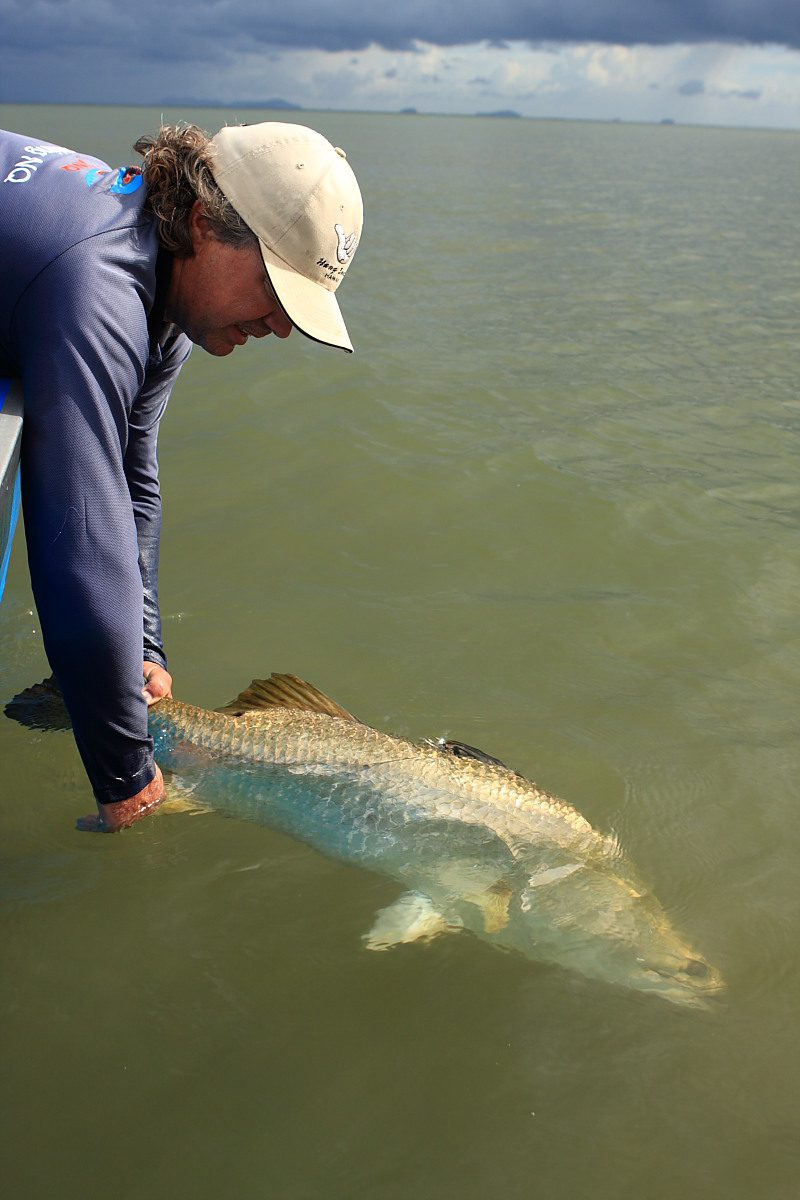
- Release in Safe Areas: Release smaller fish into bank-side covers or snags to provide protection while they recover.
Handling Deeply Hooked Fish
- Cut the Line: If the fish is deeply hooked, cut the line close to the mouth and leave the hook in place. This reduces the risk of further injury.
- Remove Hooks in Water: If practical and safe, remove the hooks while the fish is still in the water to minimize handling stress. If you are not chasing a photo, it’s easy with the bent nose pliers to twist the hooks out in situ.
Additional Considerations
- Barotrauma: Barotrauma mostly affects freshwater barra. It’s quite interesting that fish caught in dams in 3 metres of water can experience it. It is not a phenomenon that affects many saltwater fish. Follow guidelines to reduce barotrauma and best practices for releasing fish with barotrauma.
- Catch and Release Ethics: Practice responsible catch and release to maintain sustainable fish populations. Bigger barramundi are not good to eat so keep the odd schoolie (or fingermark is better) and release all the big fish. Back in the early days of my charters, anglers came on charter to catch the price of the charter in fillets. These days things have changed. This is why I decided to release my secrets to the world via my course Barra Basics as a kind of legacy. Plus the way the world is going these days, with so much time spent on social media and the rush of modern life… I wanted to share my love of being immersed in nature, looking for patterns, nutting out problems, and understanding how and why fish move. It’s a way of life.
- Follow local regulations and guidelines: Ignorance is not an excuse so no matter where you live, look up your state fisheries department and get familiar with the rules and regs of the fishery. These rules can change and they don’t notify you, you’ve got to hear it on the grapevine. Fines are expensive so make the effort to look things up.
Learn How to Catch More Barramundi with our FREE Barra Strategies Workshop
As we finish up, it’s clear we’ve just started on the road to mastering barramundi fishing. We’ve covered basics like prime locations selecting the right gear general techniques and practicing responsible fishing. However, as you can tell, mastering barramundi fishing requires ongoing dedication, learning, and refinement and there’s still much more to discover to become a proficient barramundi angler. It can also be quite confusing with so many variables. It might seem impossible to nut out the patterns.
If you’ve ever poured your heart into planning a barramundi fishing trip, only to end up with disappointing results, you’ll know what I mean. It’s frustrating and disheartening when things don’t go as planned, making you either want to throw in the towel or ignite the fire within to figure it out and make things work.
If you’ve been reading so far, you’re probably familiar with one of these 3 things:
- Inconsistent Results: Do you struggle with catching barramundi consistently? Maybe you’d like to start chasing a better class of fish? It’s disappointing to invest time and resources without seeing the expected results.
- Lack of Effective Strategies: Are you tired of guessing where to find fish and when they’ll be there? Without proven strategies, fishing trips can feel like a gamble. OR you’re out there and wondering if you should persevere or hit the pub?
- Limited Time: Many anglers don’t have endless hours to spend on the water experimenting. You need strategies that maximize your time and effort.
That’s exactly why we’re offering you our FREE Barra Strategies Workshop! This workshop will explain the exact process I have used myself to nut out barra movements over time.
Our Workshop Provides:
- Proven Processes: This is the exact process I used to learn fish patterns and predict their movements. It’s all about fishing with strategy and turning fishing into catching. We look at the low-hanging fruit first, namely barra aggregations. However, it will require you to change the way you approach your fishing trips. Yes changing bad habits! If you’re a beginner even better, as you won’t have any bad habits YET. It really is astonishing how many people I see fishing and completely wasting their time. Sure you’ll hook the odd good fish occasionally. But I prefer to think that fishing is about skill – not luck!
- Step-by-Step Guidance: In three short videos we break down complex techniques into easy-to-follow steps. You’ll learn both theory and practice, ensuring you can replicate the strategies on your trips.
- Efficiency: Save time by learning how to identify fish behavior patterns quickly and effectively. Once you can predict fish movements. you’ll spend less time searching and more time catching.
As a member of our community, you’ll also receive:
- Weekly Fishing Tips: Get free fishing tips from master angler Ryan Moody every week, keeping you updated with the latest insights and techniques.
- Chance to Win: Enter for a chance to win a barra fishing session with me, offering you a hands-on experience with expert guidance.
- No Commitment: Unsubscribe at any time if you’re not getting the value you expected.
CLICK HERE to sign up now and start your journey toward becoming a master angler. Join thousands of satisfied members who have dramatically improved their catch rates and fishing enjoyment. Whether you’re a beginner or a seasoned angler, our workshop has something to offer everyone.


